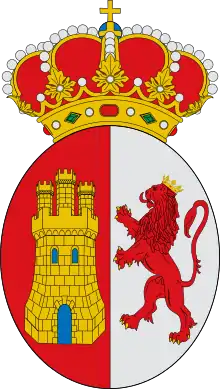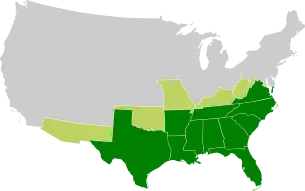Florida
Florida (/ˈflɒrɪdə/ (![]() listen),[14] Spanish pronunciation: [floˈɾiða]) is a state located in the southeastern region of the United States. With a population of over 21 million, Florida is the third-most populous and the 22nd-most extensive of the 50 United States. The state is bordered to the west by the Gulf of Mexico, to the northwest by Alabama, to the north by Georgia, to the east by the Atlantic Ocean, and to the south by the Straits of Florida. The state's capital is Tallahassee and its most populous municipality is Jacksonville. The Miami metropolitan area, with a population of almost 6.2 million, is the most populous urban area in Florida and the seventh-most populous in the United States. Other urban areas in the state with a population of more than one million are Tampa Bay, Orlando, and Jacksonville. Florida's $1.0 trillion economy is the fourth-largest of any U.S. state, and if it were a country, Florida would be the 16th-largest economy in the world.[15]
listen),[14] Spanish pronunciation: [floˈɾiða]) is a state located in the southeastern region of the United States. With a population of over 21 million, Florida is the third-most populous and the 22nd-most extensive of the 50 United States. The state is bordered to the west by the Gulf of Mexico, to the northwest by Alabama, to the north by Georgia, to the east by the Atlantic Ocean, and to the south by the Straits of Florida. The state's capital is Tallahassee and its most populous municipality is Jacksonville. The Miami metropolitan area, with a population of almost 6.2 million, is the most populous urban area in Florida and the seventh-most populous in the United States. Other urban areas in the state with a population of more than one million are Tampa Bay, Orlando, and Jacksonville. Florida's $1.0 trillion economy is the fourth-largest of any U.S. state, and if it were a country, Florida would be the 16th-largest economy in the world.[15]
Florida | |
|---|---|
| State of Florida | |
| Nickname(s): | |
| Motto(s): | |
| Anthem: "Old Folks at Home" and "Florida" | |
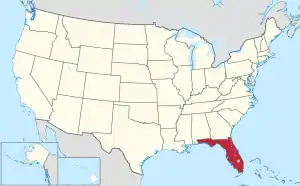 Map of the United States with Florida highlighted | |
| Country | United States |
| Before statehood | Florida Territory |
| Admitted to the Union | March 3, 1845 (27th) |
| Capital | Tallahassee[1] |
| Largest city | Jacksonville[5] |
| Largest metro | South Florida |
| Government | |
| • Governor | Ron DeSantis (R) |
| • Lieutenant Governor | Jeanette Núñez (R) |
| Legislature | Florida Legislature |
| • Upper house | Senate |
| • Lower house | House of Representatives |
| Judiciary | Supreme Court of Florida |
| U.S. senators | Marco Rubio (R) Rick Scott (R) |
| U.S. House delegation | 16 Republicans 11 Democrats (list) |
| Area | |
| • Total | 65,757.70[6] sq mi (170,312 km2) |
| Area rank | 22nd |
| Dimensions | |
| • Length | 447 mi (721 km) |
| • Width | 361 mi (582 km) |
| Elevation | 100 ft (30 m) |
| Highest elevation | 345 ft (105 m) |
| Lowest elevation (Atlantic Ocean[7]) | 0 ft (0 m) |
| Population (2020) | |
| • Total | 21,733,312 [9] |
| • Rank | 3rd |
| • Density | 384.3/sq mi (121.0/km2) |
| • Density rank | 8th |
| • Median household income | $53,267[10] |
| • Income rank | 40th |
| Demonym(s) | Floridian, Floridan |
| Language | |
| • Official language | English[11] |
| • Spoken language | Predominantly English and Spanish[12] |
| Time zones | |
| Peninsula and "Big Bend" region | UTC−05:00 (Eastern) |
| • Summer (DST) | UTC−04:00 (EDT) |
| Panhandle west of the Apalachicola River | UTC−06:00 (Central) |
| • Summer (DST) | UTC−05:00 (CDT) |
| USPS abbreviation | FL |
| ISO 3166 code | US-FL |
| Traditional abbreviation | Fla. |
| Latitude | 24° 27' N to 31° 00' N |
| Longitude | 80° 02' W to 87° 38' W |
| Website | myflorida |
The first European contact was made in 1513 by Spanish explorer Juan Ponce de León, who called it la Florida ([la floˈɾiða] "the land of flowers") upon landing there.[16] At various points in its colonial history, Florida was administered by Spain and Great Britain. Florida was admitted as the 27th state on March 3, 1845. Florida was the principal location of the Seminole Wars (1816 – 1858), the longest and most extensive of Indian Wars in United States history. Florida declared its secession from the Union on January 10, 1861, and was one of the seven original Confederate States. After the Civil War, Florida was restored to the Union on June 25, 1868.
Today, Florida is distinctive for its large Cuban expatriate community and high population growth, as well as for its increasing environmental issues. The state's economy relies mainly on tourism, agriculture, and transportation, which developed in the late 19th century. Florida is also renowned for amusement parks, orange crops, winter vegetables, the Kennedy Space Center, and as a popular destination for retirees. It is the flattest state in the United States,[17] and Lake Okeechobee is its largest freshwater lake.[18]
The state's close proximity to the ocean influences many aspects of Florida culture and daily life. Florida is a reflection of influences and multiple inheritance; African, European, indigenous, Latino, and Asian heritages can be found in the architecture and cuisine. Florida has attracted many writers such as Marjorie Kinnan Rawlings, Ernest Hemingway and Tennessee Williams, and continues to attract celebrities and athletes. It is internationally known for golf, tennis, auto racing, and water sports. Several beaches in Florida have turquoise and emerald-colored coastal waters.[19]
About two-thirds of Florida occupies a peninsula between the Gulf of Mexico and the Atlantic Ocean. Florida has the longest coastline in the contiguous United States, approximately 1,350 miles (2,170 km), not including the contribution of the many barrier islands.[20] Florida has a total of 4,510 islands that are ten acres (4 ha) or larger in area.[21][22] This is the second-highest number of islands of any state; only Alaska has more.[21] It is the only state that borders both the Gulf of Mexico and the Atlantic Ocean. Much of the state is at or near sea level, and is characterized by sedimentary soil. Florida has the lowest high point of any U.S. state at just 345 feet (105 meters). The American alligator, American crocodile, American flamingo, Roseate spoonbill, Florida panther, bottlenose dolphin, and manatee can be found in Everglades National Park in the southern part of the state. The climate varies from subtropical in the north to tropical in the south.[23] Along with Hawaii, Florida is one of only two states that have a tropical climate, and is the only continental state that has both a tropical climate and a coral reef. The Florida Reef[24] is the only living coral barrier reef in the continental United States,[25] and the third-largest coral barrier reef system in the world (after the Great Barrier Reef and Belize Barrier Reef).[26]
History
By the 16th century, the earliest time for which there is a historical record, major Native American groups included the Apalachee of the Florida Panhandle, the Timucua of northern and central Florida, the Ais of the central Atlantic coast, the Tocobaga of the Tampa Bay area, the Calusa of southwest Florida and the Tequesta of the southeastern coast.
European arrival
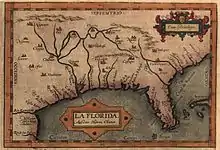
Florida was the first region of the continental United States to be visited and settled by Europeans. The earliest known European explorers came with the Spanish conquistador Juan Ponce de León. Ponce de León spotted and landed on the peninsula on April 2, 1513. He named it La Florida in recognition of the verdant landscape and because it was the Easter season, which the Spaniards called Pascua Florida (Festival of Flowers). The following day they came ashore to seek information and take possession of this new land.[27][28] The story that he was searching for the Fountain of Youth is mythical and appeared only long after his death.[29]
In May 1539, Conquistador Hernando de Soto skirted the coast of Florida, searching for a deep harbor to land. He described a thick wall of red mangroves spread mile after mile, some reaching as high as 70 feet (21 m), with intertwined and elevated roots making landing difficult.[30] The Spanish introduced Christianity, cattle, horses, sheep, the Castilian language, and more to Florida.[31] Spain established several settlements in Florida, with varying degrees of success. In 1559, Don Tristán de Luna y Arellano established a settlement at present-day Pensacola, making it the first attempted settlement in Florida, but it was mostly abandoned by 1561.
In 1564-65 there was a French settlement at Fort Caroline, in present Duval County, which was destroyed by the Spanish.[32]
In 1565, the settlement of St. Augustine (San Agustín) was established under the leadership of admiral and governor Pedro Menéndez de Avilés, creating what would become one of the oldest, continuously-occupied European settlements in the continental U.S. and establishing the first generation of Floridanos and the Government of Florida.[33] Spain maintained strategic control over the region by converting the local tribes to Christianity. The marriage between Luisa de Abrego, a free black domestic servant from Seville, and Miguel Rodríguez, a white Segovian, occurred in 1565 in St. Augustine. It is the first recorded Christian marriage in the continental United States.[34]
Some Spanish married or had unions with Pensacola, Creek or African women, both slave and free, and their descendants created a mixed-race population of mestizos and mulattos. The Spanish encouraged slaves from the Thirteen Colonies to come to Florida as a refuge, promising freedom in exchange for conversion to Catholicism. King Charles II of Spain issued a royal proclamation freeing all slaves who fled to Spanish Florida and accepted conversion and baptism. Most went to the area around St. Augustine, but escaped slaves also reached Pensacola. St. Augustine had mustered an all-black militia unit defending Spanish Florida as early as 1683.[35]

The geographical area of Spanish claims in La Florida diminished with the establishment of English settlements to the north and French claims to the west. English colonists and buccaneers launched several attacks on St. Augustine in the 17th and 18th centuries, razing the city and its cathedral to the ground several times. Spain built the Castillo de San Marcos in 1672 and Fort Matanzas in 1742 to defend Florida's capital city from attacks, and to maintain its strategic position in the defense of the Captaincy General of Cuba and the Spanish West Indies.
In 1738, the Spanish governor of Florida Manuel de Montiano established Fort Gracia Real de Santa Teresa de Mose near St. Augustine, a fortified town for escaped slaves to whom Montiano granted citizenship and freedom in return for their service in the Florida militia, and which became the first free black settlement legally sanctioned in North America.[36][37]
In 1763, Spain traded Florida to the Kingdom of Great Britain for control of Havana, Cuba, which had been captured by the British during the Seven Years' War. The trade was done as part of the 1763 Treaty of Paris which ended the Seven Year's War. Spain was granted Louisiana from France due to their loss of Florida. A large portion of the Florida population left, taking along large portions of the remaining indigenous population with them to Cuba.[38] The British soon constructed the King's Road connecting St. Augustine to Georgia. The road crossed the St. Johns River at a narrow point called Wacca Pilatka, or the British name "Cow Ford", reflecting the fact that cattle were brought across the river there.[39][40][41]
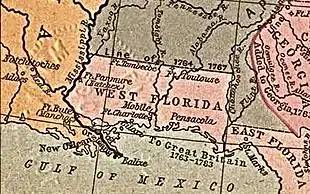
The British divided and consolidated the Florida provinces (Las Floridas) into East Florida and West Florida, a division the Spanish government kept after the brief British period.[42] The British government gave land grants to officers and soldiers who had fought in the French and Indian War in order to encourage settlement. In order to induce settlers to move to Florida, reports of its natural wealth were published in England. A number of British settlers who were described as being "energetic and of good character" moved to Florida, mostly coming from South Carolina, Georgia and England. There was also a group of settlers who came from the colony of Bermuda. This would be the first permanent English-speaking population in what is now Duval County, Baker County, St. Johns County and Nassau County. The British constructed high-quality public roads and introduced the cultivation of sugar cane, indigo and fruits as well as the export of lumber.[43][44]
The British governors were directed to call general assemblies as soon as possible in order to make laws for the Floridas, and in the meantime they were, with the advice of councils, to establish courts. This was the first introduction of the English-derived legal system which Florida still has today, including trial by jury, habeas corpus and county-based government.[43][44] Neither East Florida nor West Florida sent any representatives to Philadelphia to draft the Declaration of Independence. Florida remained a Loyalist stronghold for the duration of the American Revolution.[45]
Spain regained both East and West Florida after Britain's defeat in the Revolutionary War and the subsequent Treaty of Versailles in 1783, and continued the provincial divisions until 1821.[46]
Joining the United States; Indian removal

Defense of Florida's northern border with the United States was minor during the second Spanish period. The region became a haven for escaped slaves and a base for Indian attacks against U.S. territories, and the U.S. pressed Spain for reform.
Americans of English descent and Americans of Scots-Irish descent began moving into northern Florida from the backwoods of Georgia and South Carolina. Though technically not allowed by the Spanish authorities and the Floridan government, they were never able to effectively police the border region and the backwoods settlers from the United States would continue to immigrate into Florida unchecked. These migrants, mixing with the already present British settlers who had remained in Florida since the British period, would be the progenitors of the population known as Florida Crackers.[47]
These American settlers established a permanent foothold in the area and ignored Spanish authorities. The British settlers who had remained also resented Spanish rule, leading to a rebellion in 1810 and the establishment for ninety days of the so-called Free and Independent Republic of West Florida on September 23. After meetings beginning in June, rebels overcame the garrison at Baton Rouge (now in Louisiana), and unfurled the flag of the new republic: a single white star on a blue field. This flag would later become known as the "Bonnie Blue Flag".
In 1810, parts of West Florida were annexed by proclamation of President James Madison, who claimed the region as part of the Louisiana Purchase. These parts were incorporated into the newly formed Territory of Orleans. The U.S. annexed the Mobile District of West Florida to the Mississippi Territory in 1812. Spain continued to dispute the area, though the United States gradually increased the area it occupied. In 1812, a group of settlers from Georgia, with de facto support from the U.S. federal government, attempted to overthrow the Floridan government in the province of East Florida. The settlers hoped to convince Floridans to join their cause and proclaim independence from Spain, but the settlers lost their tenuous support from the federal government and abandoned their cause by 1813.[48]
Seminoles based in East Florida began raiding Georgia settlements, and offering havens for runaway slaves. The United States Army led increasingly frequent incursions into Spanish territory, including the 1817–1818 campaign against the Seminole Indians by Andrew Jackson that became known as the First Seminole War. The United States now effectively controlled East Florida. Control was necessary according to Secretary of State John Quincy Adams because Florida had become "a derelict open to the occupancy of every enemy, civilized or savage, of the United States, and serving no other earthly purpose than as a post of annoyance to them."[49]
Florida had become a burden to Spain, which could not afford to send settlers or troops due to the devastation caused by the Peninsular War. Madrid therefore decided to cede the territory to the United States through the Adams–Onís Treaty, which took effect in 1821.[50] President James Monroe was authorized on March 3, 1821 to take possession of East Florida and West Florida for the United States and provide for initial governance.[51] Andrew Jackson, on behalf of the U.S. federal government, served as a military commissioner with the powers of governor of the newly acquired territory for a brief period.[52] On March 30, 1822, the U.S. Congress merged East Florida and part of West Florida into the Florida Territory.[53]
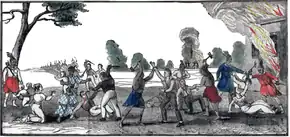
By the early 1800s, Indian removal was a significant issue throughout the southeastern U.S. and also in Florida. In 1830, the U.S. Congress passed the Indian Removal Act and as settlement increased, pressure grew on the U.S. government to remove the Indians from Florida. Seminoles offered sanctuary to blacks, and these became known as the Black Seminoles, and clashes between whites and Indians grew with the influx of new settlers. In 1832, the Treaty of Payne's Landing promised to the Seminoles lands west of the Mississippi River if they agreed to leave Florida. Many Seminole left at this time.
.jpg.webp)
Some Seminoles remained, and the U.S. Army arrived in Florida, leading to the Second Seminole War (1835–1842). Following the war, approximately 3,000 Seminole and 800 Black Seminole were removed to Indian Territory. A few hundred Seminole remained in Florida in the Everglades.
On March 3, 1845, only one day before the end of President John Tyler's term in office, Florida became the 27th state,[54] admitted as a slave state and no longer a sanctuary for runaway slaves. Initially its population grew slowly.[55]
As European settlers continued to encroach on Seminole lands, the United States intervened to move the remaining Seminoles to the West. The Third Seminole War (1855–58) resulted in the forced removal of most of the remaining Seminoles, although hundreds of Seminole Indians remained in the Everglades.[56]
Slavery, war, and disenfranchisement

American settlers began to establish cotton plantations in north Florida, which required numerous laborers, which they supplied by buying slaves in the domestic market. By 1860, Florida had only 140,424 people, of whom 44% were enslaved. There were fewer than 1,000 free African Americans before the American Civil War.[57]
On January 10, 1861, nearly all delegates in the Florida Legislature approved an ordinance of secession,[58][59] declaring Florida to be "a sovereign and independent nation"—an apparent reassertion to the preamble in Florida's Constitution of 1838, in which Florida agreed with Congress to be a "Free and Independent State." The ordinance declared Florida's secession from the Union, allowing it to become one of the founding members of the Confederate States.
The Confederacy received little help from Florida; the 15,000 men it offered were generally sent elsewhere. Instead of men and manufactured goods, Florida did provide salt and, more importantly, beef to feed the Confederate armies. This was particularly important after 1864, when the Confederacy lost control of the Mississippi River, thereby losing access to Texas beef.[60][61] The largest engagements in the state were the Battle of Olustee, on February 20, 1864, and the Battle of Natural Bridge, on March 6, 1865. Both were Confederate victories.[62] The war ended in 1865.
Reconstruction era and end of the 19th century
Following the American Civil War, Florida's congressional representation was restored on June 25, 1868, albeit forcefully after Radical Reconstruction and the installation of unelected government officials under the final authority of federal military commanders. After the Reconstruction period ended in 1876, white Democrats regained power in the state legislature. In 1885, they created a new constitution, followed by statutes through 1889 that disfranchised most blacks and many poor whites.[63]
In the pre-automobile era, railroads played a key role in the state's development, particularly in coastal areas. In 1883, the Pensacola and Atlantic Railroad connected Pensacola and the rest of the Panhandle to the rest of the state. In 1884 the South Florida Railroad (later absorbed by Atlantic Coast Line Railroad) opened full service to Tampa. In 1894 the Florida East Coast Railway reached West Palm Beach; in 1896 it reached Biscayne Bay near Miami. Numerous other railroads were built all over the interior of the state.
Until the mid-20th century, Florida was the least populous state in the southern United States. In 1900, its population was only 528,542, of whom nearly 44% were African American, the same proportion as before the Civil War.[64] The boll weevil devastated cotton crops.
Forty thousand blacks, roughly one-fifth of their 1900 population levels in Florida, left the state in the Great Migration. They left due to lynchings and racial violence, and for better opportunities in the North and the West.[65] Disfranchisement for most African Americans in the state persisted until the Civil Rights Movement of the 1960s gained federal legislation in 1965 to enforce protection of their constitutional suffrage.
20th- and 21st-century growth
.jpg.webp)
Historically, Florida's economy has been based primarily upon agricultural products such as citrus fruits, strawberries, nuts, sugarcane and cattle. [66]
In 1925, the Seaboard Air Line broke the FEC's southeast Florida monopoly and extended its freight and passenger service to West Palm Beach; two years later it extended passenger service to Miami.
Economic prosperity in the 1920s stimulated tourism to Florida and related development of hotels and resort communities. Combined with its sudden elevation in profile was the Florida land boom of the 1920s, which brought a brief period of intense land development. Devastating hurricanes in 1926 and 1928, followed by the Great Depression, brought that period to a halt. Florida's economy did not fully recover until the military buildup for World War II.
In 1939, Florida was described as "still very largely an empty State."[67] Subsequently, the growing availability of air conditioning, the climate, and a low cost of living made the state a haven. Migration from the Rust Belt and the Northeast sharply increased Florida's population after 1945. In the 1960s, many refugees from Cuba fleeing Fidel Castro's communist regime arrived in Miami at the Freedom Tower, where the federal government used the facility to process, document and provide medical and dental services for the newcomers. As a result, the Freedom Tower was also called the "Ellis Island of the South."[68] In recent decades, more migrants have come for the jobs in a developing economy.
With a population of more than 18 million, according to the 2010 census, Florida is the most populous state in the southeastern United States and the third-most populous in the United States.[69] The population of Florida has boomed in recent years with the state being the recipient of the largest number of out-of-state movers in the country as of 2019.[70] Florida's growth has been widespread, as cities throughout the state have grown since 2010.[71]
After Hurricane Maria devastated Puerto Rico in September 2017, a large population of Puerto Ricans began moving to Florida to escape the widespread destruction. Hundreds of thousands of Puerto Ricans arrived in Florida after Maria dissipated, with nearly half of them arriving in Orlando and large populations also moving to Tampa, Fort Lauderdale, and West Palm Beach.[72]
Geography

Much of Florida is on a peninsula between the Gulf of Mexico, the Atlantic Ocean and the Straits of Florida. Spanning two time zones, it extends to the northwest into a panhandle, extending along the northern Gulf of Mexico. It is bordered on the north by Georgia and Alabama, and on the west, at the end of the panhandle, by Alabama. It is the only state that borders both the Atlantic Ocean and the Gulf of Mexico. Florida also is the southernmost of the 48 contiguous states, Hawaii being the only one of the fifty states reaching farther south. Florida is west of The Bahamas and 90 miles (140 km) north of Cuba. Florida is one of the largest states east of the Mississippi River, and only Alaska and Michigan are larger in water area. The water boundary is 3 nautical miles (3.5 mi; 5.6 km) offshore in the Atlantic Ocean[73] and 9 nautical miles (10 mi; 17 km) offshore in the Gulf of Mexico.[73]
At 345 feet (105 m) above mean sea level, Britton Hill is the highest point in Florida and the lowest highpoint of any U.S. state.[74] Much of the state south of Orlando lies at a lower elevation than northern Florida, and is fairly level. Much of the state is at or near sea level. However, some places such as Clearwater have promontories that rise 50 to 100 ft (15 to 30 m) above the water. Much of Central and North Florida, typically 25 mi (40 km) or more away from the coastline, have rolling hills with elevations ranging from 100 to 250 ft (30 to 76 m). The highest point in peninsular Florida (east and south of the Suwannee River), Sugarloaf Mountain, is a 312-foot (95 m) peak in Lake County.[75] On average, Florida is the flattest state in the United States.[17]
Climate
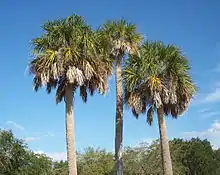
The climate of Florida is tempered somewhat by the fact that no part of the state is distant from the ocean. North of Lake Okeechobee, the prevalent climate is humid subtropical (Köppen: Cfa), while areas south of the lake (including the Florida Keys) have a true tropical climate (Köppen: Aw, Am, and Af).[76] Mean high temperatures for late July are primarily in the low 90s Fahrenheit (32–34 °C). Mean low temperatures for early to mid January range from the low 40s Fahrenheit (4–7 °C) in north Florida to above 60 °F (16 °C) from Miami on southward. With an average daily temperature of 70.7 °F (21.5 °C), it is the warmest state in the U.S.[77][78]
In the summer, high temperatures in the state rarely exceed 100 °F (37.8 °C). Several record cold maxima have been in the 30s °F (−1 to 4 °C) and record lows have been in the 10s (−12 to −7 °C). These temperatures normally extend at most a few days at a time in the northern and central parts of Florida. South Florida, however, rarely encounters below freezing temperatures.[79] The hottest temperature ever recorded in Florida was 109 °F (43 °C), which was set on June 29, 1931 in Monticello. The coldest temperature was −2 °F (−19 °C), on February 13, 1899, just 25 miles (40 km) away, in Tallahassee.[80][81]
Due to its subtropical and tropical climate, Florida rarely receives measurable snowfall.[82] However, on rare occasions, a combination of cold moisture and freezing temperatures can result in snowfall in the farthest northern regions like Jacksonville, Gainesville or Pensacola. Frost, which is more common than snow, sometimes occurs in the panhandle.[83] The USDA Plant hardiness zones for the state range from zone 8a (no colder than 10 °F or −12 °C) in the inland western panhandle to zone 11b (no colder than 45 °F or 7 °C) in the lower Florida Keys.[84] Fog also occurs all over the state or climate of Florida.[85]
| Average high and low temperatures for various Florida cities | ||||||||||||
| °F | Jan | Feb | Mar | Apr | May | Jun | Jul | Aug | Sep | Oct | Nov | Dec |
| Jacksonville[86] | 65/42 | 68/45 | 74/50 | 79/55 | 86/63 | 90/70 | 92/73 | 91/73 | 87/69 | 80/61 | 74/51 | 67/44 |
| Miami[87] | 76/60 | 78/62 | 80/65 | 83/68 | 87/73 | 89/76 | 91/77 | 91/77 | 89/76 | 86/73 | 82/68 | 78/63 |
| Orlando[88] | 71/49 | 74/52 | 78/56 | 83/60 | 88/66 | 91/72 | 92/74 | 92/74 | 90/73 | 85/66 | 78/59 | 73/52 |
| Pensacola[89] | 61/43 | 64/46 | 70/51 | 76/58 | 84/66 | 89/72 | 90/74 | 90/74 | 87/70 | 80/60 | 70/50 | 63/45 |
| Tallahassee[90] | 64/39 | 68/42 | 74/47 | 80/52 | 87/62 | 91/70 | 92/72 | 92/72 | 89/68 | 82/57 | 73/48 | 66/41 |
| Tampa[91] | 70/51 | 73/54 | 77/58 | 81/62 | 88/69 | 90/74 | 90/75 | 91/76 | 89/74 | 85/67 | 78/60 | 72/54 |
| °C | Jan | Feb | Mar | Apr | May | Jun | Jul | Aug | Sep | Oct | Nov | Dec |
| Jacksonville | 18/6 | 20/7 | 23/10 | 26/13 | 30/17 | 32/21 | 33/23 | 33/23 | 31/21 | 27/16 | 23/11 | 19/7 |
| Miami | 24/16 | 26/17 | 27/18 | 28/20 | 31/23 | 32/24 | 33/25 | 33/25 | 32/24 | 30/23 | 28/20 | 26/17 |
| Orlando | 22/9 | 23/11 | 26/13 | 28/16 | 31/19 | 33/22 | 33/23 | 33/23 | 32/23 | 29/19 | 26/15 | 23/11 |
| Pensacola | 16/6 | 18/8 | 21/11 | 24/14 | 29/19 | 32/22 | 32/23 | 32/23 | 31/21 | 27/16 | 21/10 | 17/7 |
| Tallahassee | 18/4 | 20/6 | 23/8 | 27/11 | 31/17 | 33/21 | 33/22 | 33/22 | 32/20 | 28/14 | 23/9 | 19/5 |
| Tampa | 21/11 | 23/12 | 25/14 | 27/17 | 31/21 | 32/23 | 32/24 | 33/24 | 32/23 | 29/19 | 26/16 | 22/12 |
Florida's nickname is the "Sunshine State", but severe weather is a common occurrence in the state. Central Florida is known as the lightning capital of the United States, as it experiences more lightning strikes than anywhere else in the country.[92] Florida has one of the highest average precipitation levels of any state,[93] in large part because afternoon thunderstorms are common in much of the state from late spring until early autumn.[94] A narrow eastern part of the state including Orlando and Jacksonville receives between 2,400 and 2,800 hours of sunshine annually. The rest of the state, including Miami, receives between 2,800 and 3,200 hours annually.[95]
Florida leads the United States in tornadoes per area (when including waterspouts),[96] but they do not typically reach the intensity of those in the Midwest and Great Plains. Hail often accompanies the most severe thunderstorms.[97]
Hurricanes pose a severe threat each year from June 1 to November 30, particularly from August to October. Florida is the most hurricane-prone state, with subtropical or tropical water on a lengthy coastline. Of the category 4 or higher storms that have struck the United States, 83% have either hit Florida or Texas.[98]
From 1851 to 2006, Florida was struck by 114 hurricanes, 37 of them major—category 3 and above.[98] It is rare for a hurricane season to pass without any impact in the state by at least a tropical storm.[99]
In 1992, Florida was the site of what was then the costliest weather disaster in U.S. history, Hurricane Andrew, which caused more than $25 billion in damages when it struck during August; it held that distinction until 2005, when Hurricane Katrina surpassed it, and it has since been surpassed by six other hurricanes. Andrew is currently the second costliest hurricane in Florida's history.[100]
Fauna
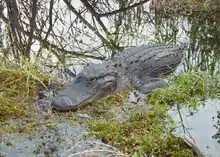
Florida is host to many types of wildlife including:
- Marine mammals: bottlenose dolphin, short-finned pilot whale, North Atlantic right whale, West Indian manatee
- Mammals: Florida panther, northern river otter, mink, eastern cottontail rabbit, marsh rabbit, raccoon, striped skunk, squirrel, white-tailed deer, Key deer, bobcats, red fox, gray fox, coyote, wild boar, Florida black bear, nine-banded armadillos, Virginia opossum
- Reptiles: eastern diamondback and pygmy rattlesnakes, gopher tortoise, green and leatherback sea turtles,[101] and eastern indigo snake. In 2012, there were about one million American alligators and 1,500 crocodiles.[102]
- Birds: peregrine falcon,[103] bald eagle, American flamingo,[104] crested caracara, snail kite, osprey, white and brown pelicans, sea gulls, whooping and sandhill cranes, roseate spoonbill, American white ibis, Florida scrub jay (state endemic), and others. One subspecies of wild turkey, Meleagris gallopavo, namely subspecies osceola, is found only in Florida.[105] The state is a wintering location for many species of eastern North American birds.
- As a result of climate change, there have been small numbers of several new species normally native to cooler areas to the north: snowy owls, snow buntings, harlequin ducks, and razorbills. These have been seen in the northern part of the state.[106]
- Invertebrates: carpenter ants, termites, American cockroach, Africanized bees, the Miami blue butterfly, and the grizzled mantis.
Florida also has more than 500 nonnative animal species and 1,000 nonnative insects found throughout the state.[107] Some exotic species living in Florida include the Burmese python, green iguana, veiled chameleon, Argentine black and white tegu, peacock bass, mayan cichlid, lionfish, White-nosed coati, rhesus macaque, vervet monkey, Cuban tree frog, cane toad, Indian peafowl, monk parakeet, tui parakeet, and many more. Some of these nonnative species do not pose a threat to any native species, but some do threaten the native species of Florida by living in the state and eating them.[108]
Flora

The state has more than 26,000 square miles (67,000 km2) of forests, covering about half of the state's land area.[109]
There are about 3,000 different types of wildflowers in Florida.[110] This is the third-most diverse state in the union, behind California and Texas, both larger states.[111] In Florida, wild populations of coconut palms extend up the East Coast from Key West to Jupiter Inlet, and up the West Coast from Marco Island to Sarasota. Many of the smallest coral islands in the Florida Keys are known to have abundant coconut palms sprouting from coconuts deposited by ocean currents. Coconut palms are cultivated north of south Florida to roughly Cocoa Beach on the East Coast and the Tampa Bay Area on the West Coast.[112]
On the east coast of the state, mangroves have normally dominated the coast from Cocoa Beach southward; salt marshes from St. Augustine northward. From St. Augustine south to Cocoa Beach, the coast fluctuates between the two, depending on the annual weather conditions.[106] All three mangrove species flower in the spring and early summer. Propagules fall from late summer through early autumn. Florida mangrove plant communities covered an estimated 430,000 to 540,000 acres (1,700 to 2,200 km2) in Florida in 1981. Ninety percent of the Florida mangroves are in southern Florida, in Collier, Lee, Miami-Dade and Monroe Counties.
Florida Reef
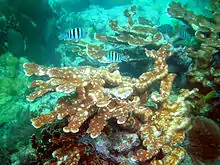
The Florida Reef is the only living coral barrier reef in the continental United States.[113] It is also the third largest coral barrier reef system in the world, after the Great Barrier Reef and the Belize Barrier Reef.[114] The reef lies a little bit off of the coast of the Florida Keys. A lot of the reef lies within John Pennekamp Coral Reef State Park, which was the first underwater park in the United States.[115] The park contains a lot of tropical vegetation, marine life, and seabirds. The Florida Reef extends into other parks and sanctuaries as well including Dry Tortugas National Park, Biscayne National Park, and the Florida Keys National Marine Sanctuary. Almost 1,400 species of marine plants and animals, including more than 40 species of stony corals and 500 species of fish, live on the Florida Reef.[116] The Florida Reef, being a delicate ecosystem like other coral reefs, faces many threats including overfishing, plastics in the ocean, coral bleaching, rising sea levels, and changes in sea surface temperature.
Environmental issues
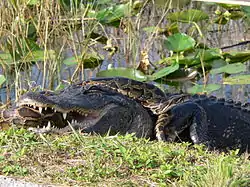
Florida is a low per capita energy user.[117] It is estimated that approximately 4% of energy in the state is generated through renewable resources.[118] Florida's energy production is 6% of the nation's total energy output, while total production of pollutants is lower, with figures of 6% for nitrogen oxide, 5% for carbon dioxide, and 4% for sulfur dioxide.[118] Wildfires in Florida occur at all times of the year.[119]
All potable water resources have been controlled by the state government through five regional water authorities since 1972.[120]
Red tide has been an issue on the southwest coast of Florida, as well as other areas. While there has been a great deal of conjecture over the cause of the toxic algae bloom, there is no evidence that it is being caused by pollution or that there has been an increase in the duration or frequency of red tides.[121] Red tide is now killing off wildlife or Tropical fish and coral reefs putting all in danger.[122]
The Florida panther is close to extinction. A record 23 were killed in 2009, mainly by automobile collisions, leaving about 100 individuals in the wild. The Center for Biological Diversity and others have therefore called for a special protected area for the panther to be established.[123] Manatees are also dying at a rate higher than their reproduction.[124] American flamingos are rare to see in Florida due to being hunted in the 1900s, where it was to a point considered completely extirpated. Now the flamingos are reproducing toward making a comeback to South Florida since it is adamantly considered native to the state and also are now being protected.[125][126]
Much of Florida has an elevation of less than 12 feet (3.7 m), including many populated areas. Therefore, it is susceptible to rising sea levels associated with global warming.[127] The Atlantic beaches that are vital to the state's economy are being washed out to sea due to rising sea levels caused by climate change. The Miami beach area, close to the continental shelf, is running out of accessible offshore sand reserves.[128] Elevated temperatures can damage coral reefs, causing coral bleaching. The first recorded bleaching incident on the Florida Reef was in 1973. Incidents of bleaching have become more frequent in recent decades, in correlation with a rise in sea surface temperatures. White band disease has also adversely affected corals on the Florida Reef.[129]
Geology
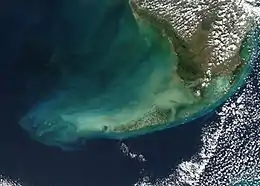
The Florida peninsula is a porous plateau of karst limestone sitting atop bedrock known as the Florida Platform.
The largest deposits of potash in the United States are found in Florida.[131] The largest deposits of rock phosphate in the country are found in Florida.[131] Most of this is in Bone Valley.[132]
Extended systems of underwater caves, sinkholes and springs are found throughout the state and supply most of the water used by residents.[133] The limestone is topped with sandy soils deposited as ancient beaches over millions of years as global sea levels rose and fell. During the last glacial period, lower sea levels and a drier climate revealed a much wider peninsula, largely savanna.[134] While there are sinkholes in much of the state, modern sinkholes have tended to be in West-Central Florida.[135][136] Everglades National Park covers 1,509,000 acres (6,110 km2), throughout Dade, Monroe, and Collier counties in Florida. The Everglades, an enormously wide, slow-flowing river encompasses the southern tip of the peninsula. Sinkhole damage claims on property in the state exceeded a total of $2 billion from 2006 through 2010.[137] Winter Park Sinkhole, in central Florida, appeared May 8, 1981. It was approximately 350 feet (107 m) wide and 75 feet (23 m) deep. It was notable as one of the largest recent sinkholes to form in the United States. It is now known as Lake Rose.[138] The Econlockhatchee River (Econ River for short) is an 87.7-kilometer-long (54.5 mi)[139] north-flowing blackwater tributary of the St. Johns River, the longest river in the U.S. state of Florida. The Econ River flows through Osceola, Orange, and Seminole counties in Central Florida, just east of the Orlando Metropolitan Area (east of State Road 417). It is a designated Outstanding Florida Waters.[140]
Earthquakes are rare because Florida is not located near any tectonic plate boundaries.[141]
Regions
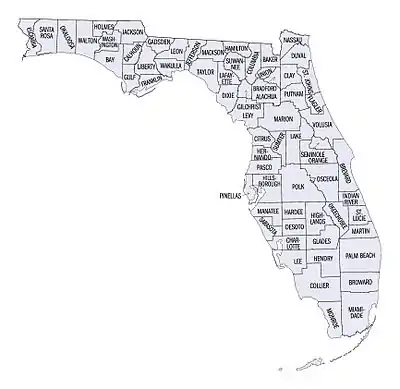
Demographics
Population

| Historical population | |||
|---|---|---|---|
| Census | Pop. | %± | |
| 1830 | 34,730 | — | |
| 1840 | 54,477 | 56.9% | |
| 1850 | 87,445 | 60.5% | |
| 1860 | 140,424 | 60.6% | |
| 1870 | 187,748 | 33.7% | |
| 1880 | 269,493 | 43.5% | |
| 1890 | 391,422 | 45.2% | |
| 1900 | 528,542 | 35.0% | |
| 1910 | 752,619 | 42.4% | |
| 1920 | 968,470 | 28.7% | |
| 1930 | 1,468,211 | 51.6% | |
| 1940 | 1,897,414 | 29.2% | |
| 1950 | 2,771,305 | 46.1% | |
| 1960 | 4,951,560 | 78.7% | |
| 1970 | 6,789,443 | 37.1% | |
| 1980 | 9,746,324 | 43.6% | |
| 1990 | 12,937,926 | 32.7% | |
| 2000 | 15,982,378 | 23.5% | |
| 2010 | 18,801,310 | 17.6% | |
| 2019 (est.) | 21,477,737 | 14.2% | |
| Sources: 1910–2010[142] 2019 Estimate[9] | |||
The United States Census Bureau estimates that the population of Florida was 21,477,737 on July 1, 2019, a 14.24% increase since the 2010 United States Census.[143] The population of Florida in the 2010 census was 18,801,310.[144] Florida was the seventh fastest-growing state in the U.S. in the 12-month period ending July 1, 2012.[145] In 2010, the center of population of Florida was located between Fort Meade and Frostproof. The center of population has moved less than 5 miles (8 km) to the east and approximately 1 mile (1.6 km) to the north between 1980 and 2010 and has been located in Polk County since the 1960 census.[146] The population exceeded 19.7 million by December 2014, surpassing the population of the state of New York for the first time, making Florida the third most populous state.[147][148] The Florida population was 21,477,737 residents or people according to the U.S. Census Bureau's 2019 Population Estimates Program.[149]
Florida contains the highest percentage of people over 65 (17%) in the US.[150] There were 186,102 military retirees living in the state in 2008.[151] About two-thirds of the population was born in another state, the second highest in the U.S.[152]
In 2010, undocumented immigrants constituted an estimated 5.7% of the population. This was the sixth highest percentage of any U.S. state.[153][154] There were an estimated 675,000 illegal immigrants in the state in 2010.[155] Florida has banned sanctuary cities.[156]
| Racial composition | 1970[157] | 1990[157] | 2000[158] | 2010[159] | 2018[160] |
|---|---|---|---|---|---|
| Black or African American alone | 15.3% | 13.6% | 14.6% | 16.0% | 16.9% |
| Asian alone | 0.2% | 1.2% | 1.7% | 2.4% | 3.0% |
| Hispanic or Latino (of any race) | 6.6% | 12.2% | 16.8% | 22.5% | 26.1% |
| Native American alone | 0.1% | 0.3% | 0.3% | 0.4% | 0.5% |
| Two or more races | — | — | 2.3% | 2.5% | 2.2% |
| White alone, not Hispanic or Latino | 77.9% | 73.2% | 65.4% | 57.9% | 53.5% |
| White alone | 84.2% | 83.1% | 78.0% | 75.0% | 77.3% |
Hispanic and Latinos of any race made up 22.5% of the population in 2010.[161] As of 2011, 57% of Florida's population younger than age 1 had at least one parent who was not non-Hispanic white.[162]
Cities and towns
The largest metropolitan area in the state as well as the entire southeastern United States is the Miami metropolitan area, with about 6.06 million people. The Tampa Bay Area, with more than 3.02 million, is the second largest; the Orlando metropolitan area, with more than 2.44 million, is third; and the Jacksonville metropolitan area, with more than 1.47 million, is fourth.[163]
Florida has 22 Metropolitan Statistical Areas (MSAs) defined by the United States Office of Management and Budget (OMB). Forty-three of Florida's 67 counties are in a MSA.
The legal name in Florida for a city, town or village is "municipality". In Florida there is no legal difference between towns, villages and cities.[164]
Florida is a highly urbanized state, with 89 percent of its population living in urban areas in 2000, compared to 79 percent nationally.[165]
In 2012, 75% of the population lived within 10 miles (16 km) of the coastline.[166]
Ancestry
In 2010, 6.9% of the population (1,269,765) considered themselves to be of only American ancestry (regardless of race or ethnicity).[168][169] Many of these were of English or Scotch-Irish descent; however, their families have lived in the state for so long they choose to identify as having "American" ancestry or do not know their ancestry.[170][171][172][173][174][175] In the 1980 United States census, the largest ancestry group reported in Florida was English with 2,232,514 Floridians claiming they were of English or mostly English American ancestry.[176] Some of their ancestry went back to the original thirteen colonies.
As of 2010, those of (non-Hispanic white) European ancestry accounted for 57.9% of Florida's population. Out of the 57.9%, the largest groups were 12.0% German (2,212,391), 10.7% Irish (1,979,058), 8.8% English (1,629,832), 6.6% Italian (1,215,242), 2.8% Polish (511,229), and 2.7% French (504,641).[168][169] White Americans of all European backgrounds are present in all areas of the state. In 1970, non-Hispanic whites were nearly 80% of Florida's population.[177] Those of English and Irish ancestry are present in large numbers in all the urban/suburban areas across the state. Some native white Floridians, especially those who have descended from long-time Florida families, may refer to themselves as "Florida crackers"; others see the term as a derogatory one. Like whites in most other states of the southern U.S., they descend mainly from English and Scots-Irish settlers, as well as some other British American settlers.[178]

As of 2010, those of Hispanic or Latino ancestry accounted for 22.5% (4,223,806) of Florida's population. Out of the 22.5%, the largest groups were 6.5% (1,213,438) Cuban, and 4.5% (847,550) Puerto Rican.[180] Florida's Hispanic population includes large communities of Cuban Americans in Miami and Tampa, Puerto Ricans in Orlando and Tampa, and Mexican/Central American migrant workers. The Hispanic community continues to grow more affluent and mobile. Florida has a large and diverse Hispanic population, with Cubans and Puerto Ricans being the largest groups in the state. Nearly 80% of Cuban Americans live in Florida, especially South Florida where there is a long-standing and affluent Cuban community.[181] Florida has the second largest Puerto Rican population after New York, as well as the fastest-growing in the nation.[182] Puerto Ricans are more widespread throughout the state, though the heaviest concentrations are in the Orlando area of Central Florida.[183] Florida has one of the largest and most diverse Hispanic/Latino populations in the country, especially in South Florida around Miami, and to a lesser degree Central Florida. Aside from the dominant Cuban and Puerto Rican populations, there are also large populations of Mexicans, Colombians, and Dominicans, among numerous other groups, as most Latino groups have sizable numbers in the state.
As of 2010, those of African ancestry accounted for 16.0% of Florida's population, which includes African Americans. Out of the 16.0%, 4.0% (741,879) were West Indian or Afro-Caribbean American.[168][169][180] During the early 1900s, black people made up nearly half of the state's population.[184] In response to segregation, disfranchisement and agricultural depression, many African Americans migrated from Florida to northern cities in the Great Migration, in waves from 1910 to 1940, and again starting in the later 1940s. They moved for jobs, better education for their children and the chance to vote and participate in society. By 1960, the proportion of African Americans in the state had declined to 18%.[185] Conversely, large numbers of northern whites moved to the state. Today, large concentrations of black residents can be found in northern and central Florida. Aside from blacks descended from African slaves brought to the southern U.S., there are also large numbers of blacks of West Indian, recent African, and Afro-Latino immigrant origins, especially in the Miami/South Florida area.[186] Florida has the largest West Indian population of any state, originating from many Caribbean countries, with Haitian Americans being the most numerous.
In 2016, Florida had the highest percentage of West Indians in the United States at 4.5%, with 2.3% (483,874) from Haitian ancestry, 1.5% (303,527) Jamaican, and 0.2% (31,966) Bahamian, with the other West Indian groups making up the rest.[187]
As of 2010, those of Asian ancestry accounted for 2.4% of Florida's population.[168][169]
Languages
In 1988, English was affirmed as the state's official language in the Florida Constitution. Spanish is also widely spoken, especially as immigration has continued from Latin America.[188] Twenty percent of the population speak Spanish as their first language. Twenty-seven percent of Florida's population reports speaking a mother language other than English, and more than 200 first languages other than English are spoken at home in the state.[189][190]
The most common languages spoken in Florida as a first language in 2010 are:[189]
- 73% English
- 20% Spanish
- 2% Haitian Creole
- Other languages less than 1% each
Religion

Florida is mostly Christian, although there is a large irreligious and relatively significant Jewish community. Protestants account for almost half of the population, but the Catholic Church is the largest single denomination in the state mainly due to its large Hispanic population and other groups like Haitians. Protestants are very diverse, although Baptists, Methodists, Pentecostals and nondenominational Protestants are the largest groups. There is also a sizable Jewish community in South Florida. This is the largest Jewish population in the southern U.S. and the third-largest in the U.S. behind those of New York and California.[191]
In 2010, the three largest denominations in Florida were the Catholic Church, the Southern Baptist Convention, and the United Methodist Church.[192]
The Pew Research Center survey in 2014 gave the following religious makeup of Florida:[193]
Governance
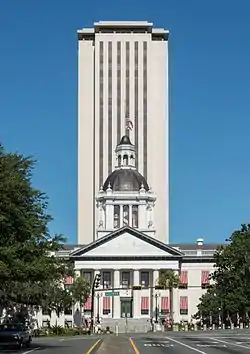
The basic structure, duties, function, and operations of the government of the State of Florida are defined and established by the Florida Constitution, which establishes the basic law of the state and guarantees various rights and freedoms of the people. The state government consists of three separate branches: judicial, executive, and legislative. The legislature enacts bills, which, if signed by the governor, become law.
The Florida Legislature comprises the Florida Senate, which has 40 members, and the Florida House of Representatives, which has 120 members. The current governor of Florida is Ron DeSantis. The Florida Supreme Court consists of a chief justice and six justices.
Florida has 67 counties. Some reference materials may show only 66 because Duval County is consolidated with the City of Jacksonville. There are 379 cities in Florida (out of 411) that report regularly to the Florida Department of Revenue, but there are other incorporated municipalities that do not. The state government's primary revenue source is sales tax. Florida does not impose a personal income tax. The primary revenue source for cities and counties is property tax; unpaid taxes are subject to tax sales, which are held (at the county level) in May and (due to the extensive use of online bidding sites) are highly popular.
There were 800 federal corruption convictions from 1988 to 2007, more than any other state.[195]
Elections history
From 1952 to 1964, most voters were registered Democrats, but the state voted for the Republican presidential candidate in every election except for 1964. The following year, Congress passed and President Lyndon B. Johnson signed the Voting Rights Act of 1965, providing for oversight of state practices and enforcement of constitutional voting rights for African Americans and other minorities in order to prevent the discrimination and disenfranchisement which had excluded most of them for decades from the political process.
From the 1930s through much of the 1960s, Florida was essentially a one-party state dominated by white conservative Democrats, who together with other Democrats of the "Solid South", exercised considerable control in Congress. They have gained slightly less federal money from national programs than they have paid in taxes.[196] Since the 1970s, conservative white voters in the state have largely shifted from the Democratic to the Republican Party. Though the majority of registered voters in Florida are Democrats,[197] it continued to support Republican presidential candidates through 2004, except in 1976 and 1996, when the Democratic nominee was from "the South".
In the 2008 and 2012 presidential elections, Barack Obama carried the state as a northern Democrat, attracting high voter turnout, especially among the young, Independents, and minority voters, of whom Hispanics comprise an increasingly large proportion. 2008 marked the first time since 1944, when Franklin D. Roosevelt carried the state for the fourth time, that Florida was carried by a Northern Democrat for president.
The first post-Reconstruction era Republican elected to Congress from Florida was William C. Cramer in 1954 from Pinellas County on the Gulf Coast,[198] where demographic changes were underway. In this period, African Americans were still disenfranchised by the state's constitution and discriminatory practices; in the 19th century, they had made up most of the Republican Party. Cramer built a different Republican Party in Florida, attracting local white conservatives and transplants from northern and midwestern states. In 1966, Claude R. Kirk, Jr. was elected as the first post-Reconstruction Republican governor, in an upset election.[199] In 1968, Edward J. Gurney, also a white conservative, was elected as the state's first post-reconstruction Republican US senator.[200] In 1970, Democrats took the governorship and the open US Senate seat, and maintained dominance for years.
Since the mid-20th century, Florida has been considered a bellwether, voting for 15 successful presidential candidates since 1952. During such period, it has voted for a losing candidate only twice.[201]
In 1998, Democratic voters dominated areas of the state with a high percentage of racial minorities and transplanted white liberals from the northeastern United States, known colloquially as "snowbirds".[202] South Florida and the Miami metropolitan area are dominated by both racial minorities and white liberals. Because of this, the area has consistently voted as one of the most Democratic areas of the state. The Daytona Beach area is similar demographically and the city of Orlando has a large Hispanic population, which has often favored Democrats. Republicans, made up mostly of white conservatives, have dominated throughout much of the rest of Florida, particularly in the more rural and suburban areas. This is characteristic of its voter base throughout the Deep South.[202]
The fast-growing I-4 corridor area, which runs through Central Florida and connects the cities of Daytona Beach, Orlando, and Tampa/St. Petersburg, has had a fairly even breakdown of Republican and Democratic voters. The area is often seen as a merging point of the conservative northern portion of the state and the liberal southern portion, making it the biggest swing area in the state. Since the late 20th century, the voting results in this area, containing 40% of Florida voters, has often determined who will win the state in federal presidential elections.[203]
The Democratic Party has maintained an edge in voter registration, both statewide and in 40 of the 67 counties, including Miami-Dade, Broward, and Palm Beach counties, the state's three most populous.[204]
2000–present
In 2000, George W. Bush won the U.S. presidential election by a margin of 271–266 in the Electoral College.[205] Of the 271 electoral votes for Bush, 25 were cast by electors from Florida.[206] The Florida results were contested and a recount was ordered by the court, with the results settled in a Supreme Court decision, Bush v. Gore.
Reapportionment following the 2010 United States Census gave the state two more seats in the House of Representatives.[207] The legislature's redistricting, announced in 2012, was quickly challenged in court, on the grounds that it had unfairly benefited Republican interests. In 2015, the Florida Supreme Court ruled on appeal that the congressional districts had to be redrawn because of the legislature's violation of the Fair District Amendments to the state constitution passed in 2010; it accepted a new map in early December 2015.
The political make-up of congressional and legislative districts has enabled Republicans to control the governorship and most statewide elective offices, and 17 of the state's 27 seats in the 2012 House of Representatives.[208] Florida has been listed as a swing state in presidential elections since 1952, voting for the losing candidate only twice in that period of time.[209]
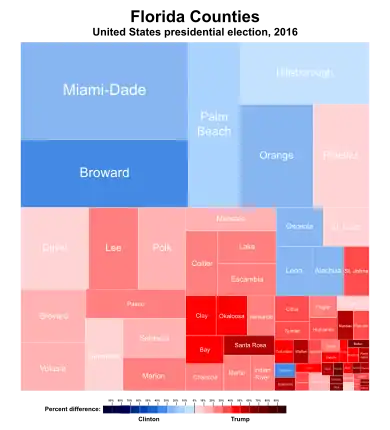
In the closely contested 2000 election, the state played a pivotal role.[205][206][210][211][212][213] Out of more than 5.8 million votes for the two main contenders Bush and Al Gore, around 500 votes separated the two candidates for the all-decisive Florida electoral votes that landed Bush the election win. Florida's felony disenfranchisement law is more severe than most European nations or other American states. A 2002 study in the American Sociological Review concluded that "if the state's 827,000 disenfranchised felons had voted at the same rate as other Floridians, Democratic candidate Al Gore would have won Florida—and the presidency—by more than 80,000 votes."[214]
In 2008, delegates of both the Republican Florida primary election and Democratic Florida primary election were stripped of half of their votes when the conventions met in August due to violation of both parties' national rules.
In the 2010 elections, Republicans solidified their dominance statewide, by winning the governor's mansion, and maintaining firm majorities in both houses of the state legislature. They won four previously Democratic-held seats to create a 19–6 Republican majority delegation representing Florida in the federal House of Representatives.
In 2010, more than 63% of state voters approved the initiated Amendments 5 and 6 to the state constitution, to ensure more fairness in districting. These have become known as the Fair District Amendments. As a result of the 2010 United States Census, Florida gained two House of Representative seats in 2012.[207] The legislature issued revised congressional districts in 2012, which were immediately challenged in court by supporters of the above amendments.
The court ruled in 2014, after lengthy testimony, that at least two districts had to be redrawn because of gerrymandering. After this was appealed, in July 2015 the Florida Supreme Court ruled that lawmakers had followed an illegal and unconstitutional process overly influenced by party operatives, and ruled that at least eight districts had to be redrawn. On December 2, 2015, a 5–2 majority of the Court accepted a new map of congressional districts, some of which was drawn by challengers. Their ruling affirmed the map previously approved by Leon County Judge Terry Lewis, who had overseen the original trial. It particularly makes changes in South Florida. There are likely to be additional challenges to the map and districts.[215]
| Party | Registered voters | Percentage | |
|---|---|---|---|
| Democratic | 4,986,520 (+10,625) | 36.83% | |
| Republican | 4,761,405 (+42,685) | 35.17% | |
| Unaffiliated | 3,641,359 (+52,841) | 26.90% | |
| Minor parties | 147,546 (+34,057) | 1.09% | |
| Total | 13,536,830 (+140,208) | 100% | |
| *Added between December 31, 2018 and December 31, 2019. | |||
According to The Sentencing Project, the effect of Florida's felony disenfranchisement law is such that in 2014, "[m]ore than one in ten Floridians—and nearly one in four African-American Floridians—are [were] shut out of the polls because of felony convictions", although they had completed sentences and parole/probation requirements.[217]
In the 2016 United States presidential and general elections, the state leaned Republican. The state's Democratic representation at the national level increased by one seat, but the overall state-wide composition was 16 Republicans to 11 Democrats. Floridians also voted 49.0% to 47.8% to elect Donald Trump over Hillary Clinton in the presidential election. With a 1.2% difference, this was the 5th closest presidential race that year, with only Wisconsin, Michigan, New Hampshire and Pennsylvania being closer.
In the 2018 elections, the ratio of Republican to Democratic representation fell from 16:11 to 14:13. The U.S. Senate election between Democratic incumbent senator Bill Nelson and former governor Rick Scott was close, with a 49.93% voting for the incumbent and 50.06% voting for the former governor. Republicans also held onto the governorship in a close race between Republican candidate Ron DeSantis and Democractic candidate Andrew Gillum, with 49.6% voting for the DeSantis and 49.3% voting for Gillum.
Statutes

In 1972, the state made personal injury protection auto insurance mandatory for drivers, becoming the second in the nation to enact a no-fault insurance law.[218] The ease of receiving payments under this law is seen as precipitating a major increase in insurance fraud.[219] Auto insurance fraud was the highest in the nation in 2011, estimated at close to $1 billion.[220] Fraud is particularly centered in the Miami-Dade and Tampa areas.[221][222][223]
Capital punishment is applied in Florida.[224] If a person committing a predicate felony directly contributed to the death of the victim then the person will be charged with murder in the first degree. The only two sentences available for that statute are life imprisonment and the death penalty.[225][226] If a person commits a predicate felony, but was not the direct contributor to the death of the victim then the person will be charged with murder in the second degree. The maximum prison term is life.[225][226] In 1995, the legislature modified Chapter 921 to provide that felons should serve at least 85% of their sentence.[227][228]
Florida approved its lottery by amending the constitution in 1984. It approved slot machines in Broward and Miami-Dade County in 2004. It has disapproved casinos (outside of sovereign Seminole and Miccosukee tribal areas) three times: 1978, 1986, and 1994.[229]
Taxation
Tax is collected by the Florida Department of Revenue.
Economy

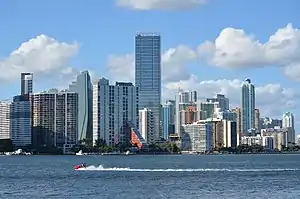
- Total employment 2017
- 8,385,577
- Total employer establishments 2017
- 557,308[232]
Florida's economy ranks among the largest in the world. As of 2018, the gross state product (GSP) is about $1.0 trillion,[233] the fourth largest economy in the United States.[233] Florida is responsible for 5 percent of the United States' approximately $21 trillion gross domestic product (GDP). As of 2018, Florida's nominal GDP is larger than all but 15 countries.[234] In terms of Purchasing Power Parity, it is larger than all but 24 countries.[235] In the 20th century, tourism, industry, construction, international banking, biomedical and life sciences, healthcare research, simulation training, aerospace and defense, and commercial space travel have contributed to the state's economic development.[236]
The five largest sectors of employment in Florida are: trade, transportation, and utilities; government; professional and business services; education and health services; and leisure and hospitality.[237] In output, the five largest sectors are: finance, insurance, real estate, rental, and leasing, followed by professional and business services; government and government enterprises; educational services, health care, and social assistance; and retail trade.[238]
In 2017, Florida became the United States' eighth largest exporter of trade goods. Florida's top countries for export are Brazil, Canada, Mexico, Germany, and Colombia.[239] In 2017, Florida became the United States' tenth largest importer of trade goods. Florida imported US$75.4 billion worth of goods globally in 2017. The value of Florida's imports equals 3.2% of United States' overall imported products for 2017. Florida's top countries for imports are China, Mexico, Canada, Germany, and France.[240]
The Miami Metropolitan Area has the highest GDP of all the metro areas in Florida with $344.9 billion in 2017.[241] This is more than twice the number of the next metro area, the Tampa Bay Area, which has a GDP of $145.3 billion. The economy of Florida is driven almost entirely by its nineteen metropolitan areas. In 2004, they had a combined total of 95.7% of the state's domestic product.[242]
Per capita GDP in 2017 was $39,842, ranking 40th in the nation.[243] Per capita income varies widely by geographic region and profession. North Florida and the rural counties of the Florida Panhandle are the most impoverished in the state. Florida has a poverty rate of 14.0%, the seventeenth lowest of any state in the country. Many coastal cities include some of the wealthiest per-capita areas in the United States.
In 2018, there were more than 427,824 millionaires in the state, the fourth highest number in the nation.[244]
For 2018–19, the approved state budget is $88.7 billion, a 4.4% increase over the previous 2017–18 budget of $84.9 billion. Chief Executive Magazine named Florida the third "Best State for Business" in 2011.[245]
Personal income
In 2017, Florida's per capita personal income was $47,684, ranking 26th in the nation.[246] The state's unemployment rate in September 2018 was 3.5% and ranked as the 18th lowest in the United States.[247] Florida is one of seven states that does not impose a personal income tax.[248]
In 2017, Florida had a personal income of $1,000,624,065 (in thousands of dollars). This personal income ranked 4th in the United States.[246]
Florida's constitution establishes a state minimum wage, which is adjusted annually for inflation. As of January 1, 2017, Florida's minimum wage was $5.08 for tipped positions, and $8.10 for non-tipped positions, which was higher than the federal rate of $7.25.[249]
Florida has two cities in the top 25 cities in the U.S. with the highest average credit card debt, Miami and Tampa.[250]
The poverty rate in Florida in 2018 was 14%, down from a peak of 17.1% in 2012.[251]
Real estate
In the early 20th century, land speculators discovered Florida, and businessmen such as Henry Plant and Henry Flagler developed railroad systems, which led people to move in, drawn by the weather and local economies. From then on, tourism boomed, fueling a cycle of development that overwhelmed a great deal of farmland.[252]
At the end of the third quarter of 2008, Florida had the highest mortgage delinquency rate in the U.S., with 7.8% of mortgages delinquent at least 60 days.[253] A 2009 list of national housing markets that were hard hit in the real estate crash included a disproportionate number in Florida.[254] The early 21st-century building boom left Florida with 300,000 vacant homes in 2009, according to state figures.[255] In 2009, the US Census Bureau estimated that Floridians spent an average 49.1% of personal income on housing-related costs, the third highest percentage in the U.S.[256]
In the third quarter of 2009, there were 278,189 delinquent loans, 80,327 foreclosures.[257] Sales of existing homes in February 2010 was 11,890, up 21% from the same month in 2009. Only two metropolitan areas showed a decrease in homes sold: Panama City and Brevard County. The average sales price for an existing house was $131,000, 7% decrease from the prior year.[258]
Tourism
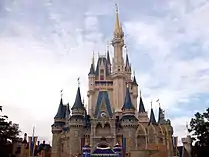
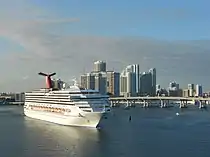
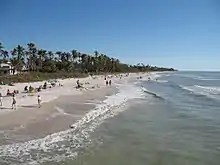
If you can't find something to do in Florida, you're just boring ...
Tourism makes up one of the largest sectors of the state economy, with nearly 1.4 million people employed in the tourism industry in 2016 (a record for the state, surpassing the 1.2 million employment from 2015).[260][261]
In 2015, Florida broke the 100-million visitor mark for the first time in state history by hosting a record 105 million visitors.[261][262] The state has set tourism records for eight consecutive years, most recently breaking the 120-million visitor mark for the first time in 2018 with 126.1 million visitors reported.[263]
Many beach towns are popular tourist destinations, particularly during winter and spring break. Twenty-three million tourists visited Florida beaches in 2000, spending $22 billion.[264] The public has a right to beach access under the public trust doctrine, but some areas have access effectively blocked by private owners for a long distance.[265]
Amusement parks, especially in the Greater Orlando area, make up a significant portion of tourism. The Walt Disney World Resort is the most visited vacation resort in the world with more than 58 million visitors annually,[266] consisting of four theme parks, 27 themed resort hotels, nine non-Disney hotels, two water parks, four golf courses and other recreational venues.[267] Other major theme parks in the area include Universal Orlando Resort, SeaWorld Orlando and Busch Gardens Tampa.[268]
Florida's many state parks and protected areas receive a lot of visitors as well with 25.2 million visitors visiting Florida State Parks in 2013.[269]
Agriculture and fishing
Agriculture is the second largest industry in the state.[270] Citrus fruit, especially oranges, are a major part of the economy, and Florida produces the majority of citrus fruit grown in the United States. In 2006, 67% of all citrus, 74% of oranges, 58% of tangerines, and 54% of grapefruit were grown in Florida. About 95% of commercial orange production in the state is destined for processing (mostly as orange juice, the official state beverage).[271]
Citrus canker continues to be an issue of concern. From 1997 to 2013, the growing of citrus trees has declined 25%, from 600,000 to 450,000 acres (240,000 to 180,000 ha). Citrus greening disease is incurable. A study states that it has caused the loss of $4.5 billion between 2006 and 2012. As of 2014, it was the major agricultural concern.[272]
The largest farm category by sales in Florida is the $2.3 billion ornamental industry, which includes nursery, greenhouse, flowers, and sod products.[273]
Other products include sugarcane, strawberries, tomatoes and celery.[274] The state is the largest producer of sweet corn and green beans for the U.S.[275]
The Everglades Agricultural Area is a major center for agriculture. The environmental impact of agriculture, especially water pollution, is a major issue in Florida today.[276]
In 2009, fishing was a $6 billion industry, employing 60,000 jobs for sports and commercial purposes.[277]
The state has a near monopoly on saw palmetto berries, an alternative medicine used to treat prostate and urinary disorders.[278]
Industry
Florida is the leading state for sales of powerboats. Boats sales totaled $1.96 billion in 2013.[279]
Mining
Phosphate mining, concentrated in the Bone Valley, is the state's third-largest industry. The state produces about 75% of the phosphate required by farmers in the United States and 25% of the world supply, with about 95% used for agriculture (90% for fertilizer and 5% for livestock feed supplements) and 5% used for other products.[280]
After the watershed events of Hurricane Andrew in 1992, Florida began investing in economic development through the Office of Trade, Tourism, and Economic Development. Governor Jeb Bush realized that watershed events such as Andrew negatively impacted Florida's backbone industry of tourism severely. The office was directed to target Medical/Bio-Sciences among others. Three years later, The Scripps Research Institute (TSRI) announced it had chosen Florida for its newest expansion. In 2003, TSRI announced plans to establish a major science center in Palm Beach, a 364,000 square feet (33,800 m2) facility on 100 acres (40 ha), which TSRI planned to occupy in 2006.[281]
Government
.jpg.webp)
Since the development of the federal NASA Merritt Island launch sites on Cape Canaveral (most notably Kennedy Space Center) in 1962, Florida has developed a sizable aerospace industry.
Another major economic engine in Florida is the United States military. There are 24 military bases in the state, housing three Unified Combatant Commands; United States Central Command in Tampa, United States Southern Command in Doral, and United States Special Operations Command in Tampa. Some 109,390 U.S. military personnel stationed in Florida,[282] contributing, directly and indirectly, $52 billion a year to the state's economy.[283]
In 2009, there were 89,706 federal workers employed within the state.[284] Tens of thousands more employees work for contractors who have federal contracts, including those with the military.
In 2012, government of all levels was a top employer in all counties in the state, because this classification includes public school teachers and other school staff. School boards employ nearly one of every thirty workers in the state. The federal military was the top employer in three counties.[285]
Seaports

Florida has many seaports that serve container ships, tank ships, and cruise lines. Major ports in Florida include Port Tampa Bay in Tampa, Port Everglades in Fort Lauderdale, Port of Jacksonville in Jacksonville, PortMiami in Miami, Port Canaveral in Brevard County, Port Manatee in Manatee County, and Port of Palm Beach in Riviera Beach. The world's top three busiest cruise ports are found in Florida with PortMiami as the busiest and Port Canaveral and Port Everglades as the second and third busiest.[286] Port Tampa Bay meanwhile is the largest in the state, having the most tonnage. As of 2013, Port Tampa Bay ranks 16th in the United States by tonnage in domestic trade, 32nd in foreign trade, and 22nd in total trade. It is the largest, most diversified port in Florida, has an economic impact of more than $15.1 billion, and supports more than 80,000 jobs.[287][288]
Health
There were 2.7 million Medicaid patients in Florida in 2009. The governor has proposed adding $2.6 billion to care for the expected 300,000 additional patients in 2011.[289] The cost of caring for 2.3 million clients in 2010 was $18.8 billion.[290] This is nearly 30% of Florida's budget.[291] Medicaid paid for 60% of all births in Florida in 2009. The state has a program for those not covered by Medicaid.
In 2013, Florida refused to participate in providing coverage for the uninsured under the Affordable Care Act, popularly called Obamacare. The Florida legislature also refused to accept additional Federal funding for Medicaid, although this would have helped its constituents at no cost to the state. As a result, Florida is second only to Texas in the percentage of its citizens without health insurance.[292]
Architecture
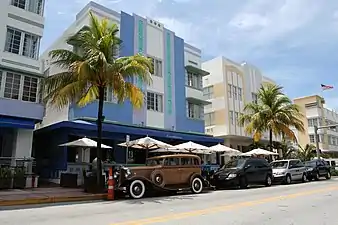
Florida has the largest collection of Art Deco and Streamline Moderne buildings, both in the United States and in the entire world, most of which are located in the Miami metropolitan area, especially Miami Beach's Art Deco District, constructed as the city was becoming a resort destination.[293] A unique architectural design found only in Florida is the post-World War II Miami Modern, which can be seen in areas such as Miami's MiMo Historic District.[294]
Being of early importance as a regional center of banking and finance, the architecture of Jacksonville displays a wide variety of styles and design principles. Many of the state's earliest skyscrapers were constructed in Jacksonville, dating as far back as 1902,[295] and last holding a state height record from 1974 to 1981.[296] The city is endowed with one of the largest collections of Prairie School buildings outside of the Midwest.[297] Jacksonville is also noteworthy for its collection of Mid-Century modern architecture.[298]
Some sections of the state feature architectural styles including Spanish revival, Florida vernacular, and Mediterranean Revival.[299] A notable collection of these styles can be found in St. Augustine, the oldest continuously occupied European-established settlement within the borders of the United States.[300]
Education
Florida overall was ranked the 7th best state in America for educating students at all levels by U.S. News & World Report in 2018.[301]
Primary and secondary education
With an educational system made up of public school districts and independent private institutions, Florida had 2,833,115 students enrolled in 4,269 public primary, secondary, and vocational schools in Florida's 67 regular or seven special school districts as of 2018.[302] Miami-Dade County is the largest of Florida's 67 regular districts with more than 350 thousand students and Jefferson is the smallest with less than one thousand students. Florida spent $8,920 for each student in 2016, and was 43rd in the nation in expenditures per student.[303]
Florida's primary and secondary school systems are administered by the Florida Department of Education. School districts are organized within county boundaries. Each school district has an elected Board of Education that sets policy, budget, goals, and approves expenditures. Management is the responsibility of a Superintendent of schools.
The Florida Department of Education is required by law to train educators in teaching English for Speakers of Other Languages (ESOL).[304]
Higher education
The State University System of Florida was founded in 1905, and is governed by the Florida Board of Governors. During the 2010 academic year, 312,216 students attended one of these twelve universities. The Florida College System comprises 28 public community and state colleges. In 2011–12, enrollment consisted of more than 875,000 students.[305] As of 2017, the University of Central Florida, with more than 64,000 students, is the largest university by enrollment in the United States.[306] Florida's first private university, Stetson University, was founded in 1883. The Independent Colleges and Universities of Florida is an association of 28 private, educational institutions in the state.[307] This Association reported that their member institutions served more than 121,000 students in the fall of 2006.[308]
In 2016, Florida charged the second lowest tuition in the nation for four years, $26,000 for in-state students, to $86,000 for out-of-state students. This compares with an average of $34,800 nationally for in-state students.[309]
| State University System of Florida | |||
|---|---|---|---|
| Institution | Location | Established | Enrollment |
| Florida A&M University | Tallahassee | 1887[lower-alpha 1] | 10,031 |
| Florida Atlantic University | Boca Raton | 1961 | 30,808 |
| Florida Gulf Coast University | Fort Myers | 1991 | 15,080 |
| Florida International University | Miami | 1965 | 58,787 |
| Florida Polytechnic University | Lakeland | 2012 | 1,236 |
| Florida State University | Tallahassee | 1851[lower-alpha 1] | 41,551 |
| New College of Florida | Sarasota | 1960 | 838 |
| University of Central Florida | Orlando | 1963 | 69,525 |
| University of Florida | Gainesville | 1853[lower-alpha 1] | 56,567 |
| University of North Florida | Jacksonville | 1972 | 17,002 |
| University of South Florida | Tampa | 1956 | 51,646 |
| University of West Florida | Pensacola | 1963 | 12,850 |
- In 1836, the United States Congress authorized the establishment of a University of Florida in the Florida Territory, to be located on lands reserved in both East and West Florida. In 1851, the Florida legislature voted to establish two seminaries of learning: West Florida Seminary (which later became Florida State University) and East Florida Seminary (which later became the University of Florida).[310] In 1905, when the Buckman Act reorganized higher education in Florida, the three resulting state institutions (Florida, Florida State, and Florida A&M) all adopted 1905 as their founding date. In 1935 the Florida Board of Control changed the founding dates of Florida and Florida State to the years their predecessor Seminaries opened: 1853 and 1857, respectively. In 2000, Florida State declared 1851 to be its founding date, reflecting the date the legislature authorized both seminaries. Florida A&M later declared its founding date to be 1885 to reflect when its predecessor, the State Normal College for Colored Students, was founded.[311]
Transportation
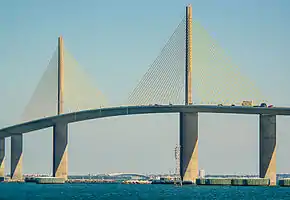
Highways
Florida's highway system contains 1,495 mi (2,406 km) of interstate highway, and 10,601 mi (17,061 km) of non-interstate highway, such as state highways and U.S. Highways. Florida's interstates, state highways, and U.S. Highways are maintained by the Florida Department of Transportation.[312]
In 2011, there were about 9,000 retail gas stations in the state. Floridians consumed 21 million gallons of gasoline daily in 2011, ranking it third in national use behind California and Texas.[313] Motorists have the 45th lowest rate of car insurance in the U.S. 24% are uninsured.[314]
Drivers between 15 and 19 years of age averaged 364 car crashes a year per ten thousand licensed Florida drivers in 2010. Drivers 70 and older averaged 95 per 10,000 during the same time frame. A spokesperson for the non-profit Insurance Institute said that "Older drivers are more of a threat to themselves."[315]
Intercity bus travel, which utilizes Florida's highway system, is provided by Greyhound, Megabus, and Amtrak Thruway Motorcoach.
Before the construction of routes under the Federal Aid Highway Act of 1956, Florida began construction of a long cross-state toll road, Florida's Turnpike. The first section, from Fort Pierce south to the Golden Glades Interchange was completed in 1957. After a second section north through Orlando to Wildwood (near present-day The Villages), and a southward extension around Miami to Homestead, it was finished in 1974.
Florida's primary interstate routes include:
 I-4, which spans 133 miles, bisects the state, connecting Tampa, Lakeland, Orlando, and Daytona Beach, connecting with I-75 in Tampa and I-95 in Daytona Beach.
I-4, which spans 133 miles, bisects the state, connecting Tampa, Lakeland, Orlando, and Daytona Beach, connecting with I-75 in Tampa and I-95 in Daytona Beach. I-10, which spans 362 miles in Florida, traverses the panhandle, connecting Pensacola, Tallahassee, Lake City, and Jacksonville, with interchanges with I-75 in Lake City and I-95 in Jacksonville. It is the southernmost east–west interstate in the United States terminating in Santa Monica with a total length of 2460 miles.
I-10, which spans 362 miles in Florida, traverses the panhandle, connecting Pensacola, Tallahassee, Lake City, and Jacksonville, with interchanges with I-75 in Lake City and I-95 in Jacksonville. It is the southernmost east–west interstate in the United States terminating in Santa Monica with a total length of 2460 miles. I-75, which spans 470 miles in Florida, enters the state near Lake City (45 miles (72 km) west of Jacksonville) and continues southward through Gainesville, Ocala, Tampa's eastern suburbs, Bradenton, Sarasota, Fort Myers and Naples, where it crosses the "Alligator Alley" as a toll road to Fort Lauderdale before turning southward and terminating in Hialeah/Miami Lakes having interchanges with I-10 in Lake City and I-4 in Tampa. It is the second longest north–south interstate with a total length of 1786 miles and terminates at the Canadian border at Sault Ste. Marie, Michigan.
I-75, which spans 470 miles in Florida, enters the state near Lake City (45 miles (72 km) west of Jacksonville) and continues southward through Gainesville, Ocala, Tampa's eastern suburbs, Bradenton, Sarasota, Fort Myers and Naples, where it crosses the "Alligator Alley" as a toll road to Fort Lauderdale before turning southward and terminating in Hialeah/Miami Lakes having interchanges with I-10 in Lake City and I-4 in Tampa. It is the second longest north–south interstate with a total length of 1786 miles and terminates at the Canadian border at Sault Ste. Marie, Michigan. I-95, which spans 382 miles in Florida, enters the state near Jacksonville and continues along the Atlantic Coast through Daytona Beach, the Melbourne/Titusville, Palm Bay, Vero Beach, Fort Pierce, Port Saint Lucie, Stuart, West Palm Beach, and Fort Lauderdale, before terminating in Downtown Miami. It has interchanges with I-10 in Jacksonville and I-4 in Daytona Beach, and there are four auxiliary routes associated with the interstate. It is the longest north–south interstate with a total length of 1924 miles and terminates at the Canadian border northeast of Houlton, Maine.
I-95, which spans 382 miles in Florida, enters the state near Jacksonville and continues along the Atlantic Coast through Daytona Beach, the Melbourne/Titusville, Palm Bay, Vero Beach, Fort Pierce, Port Saint Lucie, Stuart, West Palm Beach, and Fort Lauderdale, before terminating in Downtown Miami. It has interchanges with I-10 in Jacksonville and I-4 in Daytona Beach, and there are four auxiliary routes associated with the interstate. It is the longest north–south interstate with a total length of 1924 miles and terminates at the Canadian border northeast of Houlton, Maine.
Airports

Florida has 131 public airports.[317] Florida's seven large hub and medium hub airports, as classified by the FAA,[318] are the following:
| City served | Code | Airport name | FAA Category |
Enplanements |
|---|---|---|---|---|
| Orlando | MCO | Orlando International Airport | Large Hub | 21,565,448 |
| Miami | MIA | Miami International Airport | Large Hub | 20,709,225 |
| Fort Lauderdale | FLL | Fort Lauderdale–Hollywood Int'l Airport | Large Hub | 15,817,043 |
| Tampa | TPA | Tampa International Airport | Large Hub | 9,548,580 |
| Fort Myers | RSW | Southwest Florida International Airport | Medium Hub | 4,364,224 |
| West Palm Beach | PBI | Palm Beach International Airport | Medium Hub | 3,110,450 |
| Jacksonville | JAX | Jacksonville International Airport | Medium Hub | 2,701,861 |
Intercity rail

- Brightline is a diesel–electric higher-speed rail system.[319] Currently service is only from West Palm Beach to Miami through express intercity service, with a stop at Fort Lauderdale. The complete project is intended to connect Miami and South Florida to Orlando, which requires a new line westward from the coast. It partially opened for passenger service between Fort Lauderdale and West Palm Beach on January 13, 2018, as the only privately owned and operated passenger railroad in the United States.[320] With a top speed of 125 mph (201 km/h), Brightline will eventually be tied with Amtrak's Northeast Regional and the MARC's Penn Line commuter rail as the second fastest passenger train in North America, after Amtrak's Acela.
- Florida is also served by Amtrak, operating numerous lines throughout, connecting the state's largest cities to points north in the United States and Canada. The busiest Amtrak train stations in Florida in 2011 were: Sanford (259,944), Orlando (179,142), Tampa Union Station (140,785), Miami (94,556), and Jacksonville (74,733).[321] Sanford, in Greater Orlando, is the southern terminus of the Auto Train, which originates at Lorton, Virginia, south of Washington, D.C. Until 2005, Orlando was also the eastern terminus of the Sunset Limited, which travels across the southern United States via New Orleans, Houston, and San Antonio to its western terminus of Los Angeles. Florida is served by two additional Amtrak trains (the Silver Star and the Silver Meteor), which operate between New York City and Miami. MiamiCentral in Greater Downtown Miami and the Miami Intermodal Center near Miami International Airport are major hubs for rapid transit, commuter rail, intercity rail, and buses.
Public transit

- Miami: Miami's public transportation is served by Miami-Dade Transit that runs Metrorail, a heavy rail rapid transit system, Metromover, a people mover train system in Downtown Miami, and Metrobus, Miami's bus system. Metrorail runs throughout Miami-Dade County and has two lines and 23 stations connecting to Downtown Miami's Metromover and Tri-Rail. Metromover has three lines and 21 stations throughout Downtown Miami. Outside of Miami-Dade County, public transit in the Miami metropolitan area is served by Broward County Transit and Palm Tran; intercounty commuter rail service is provided by Tri-Rail, with 18 stations including the region's three international airports.[322]
- Orlando: Orlando is served by the SunRail commuter train, which runs on a 32 miles (51 km) (61 miles (98 km) when complete) line including four stops in downtown. Lynx bus serves the greater Orlando area in Orange, Seminole, and Osceola counties.[323]
- Tampa: Tampa and its surrounding area use the Hillsborough Area Regional Transit Authority system ("HART"). In addition, downtown Tampa has continuous trolley services in the form of a heritage trolley powered by Tampa Electric Company. Pinellas County and St. Petersburg provide similar services through the Pinellas Suncoast Transit Authority or "PSTA". The beaches of Pinellas County also have a continuous trolley bus. Downtown St. Petersburg has a trolley system.[324][325]
- Jacksonville: Jacksonville is served by the Jacksonville Skyway, an automated people mover monorail connecting the Florida State College downtown campus, the Northbank central business district, Convention Center, and Southbank locations. The system includes eight stops connected by two lines. JTA bus has 180 vehicles with 56 lines.[326]
Sports

Florida has three NFL teams, two MLB teams, two NBA teams, two NHL teams, and two MLS teams. Florida gained its first permanent major-league professional sports team in 1966 when the American Football League added the Miami Dolphins. Florida has given professional sports franchises some subsidies in the form of tax breaks since 1991.[327]
About half of all Major League Baseball teams conduct spring training in the state, with teams informally organized into the "Grapefruit League". Throughout MLB history, other teams have held spring training in Florida.
NASCAR (headquartered in Daytona Beach) begins all three of its major auto racing series in Florida at Daytona International Speedway in February, featuring the Daytona 500, and ends all three Series in November at Homestead-Miami Speedway. Daytona also has the Coke Zero Sugar 400 NASCAR race weekend around Independence Day in July. The 24 Hours of Daytona is one of the world's most prestigious endurance auto races. The Grand Prix of St. Petersburg and Grand Prix of Miami have held IndyCar races as well.
Florida is a major golf hub. The PGA of America is headquartered in Palm Beach Gardens, the PGA Tour is headquartered in Ponte Vedra Beach, and the LPGA is headquartered in Daytona Beach. The Players Championship, WGC-Cadillac Championship, Arnold Palmer Invitational, Honda Classic and Valspar Championship are PGA Tour rounds.
Florida has teams in all five American major league sports. Florida's most recent major-league team, Inter Miami, began play in MLS in 2020.[328]
The Miami Masters is an ATP World Tour Masters 1000 and WTA Premier tennis event, whereas the Delray Beach International Tennis Championships is an ATP World Tour 250 event.
Minor league baseball, football, basketball, ice hockey, soccer and indoor football teams are based in Florida.[329] Ben Hill Griffin Stadium is the largest football stadium in Florida, the 12th largest stadium in American college football, and the 18th largest stadium in the world, as measured by its official seating capacity of 88,548—though, it has often held over 90,000 for Florida's home football games.
Florida's universities have a number of collegiate sport programs. Major college football programs include the Florida State Seminoles and Miami Hurricanes of the Atlantic Coast Conference, and the Florida Gators of the Southeastern Conference.[330] Since 1996, Florida has added four additional programs to the ranks of Division I FCS: UCF Knights, South Florida Bulls, Florida Atlantic Owls and FIU Panthers.
State symbols

.jpg.webp)
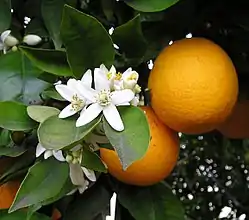
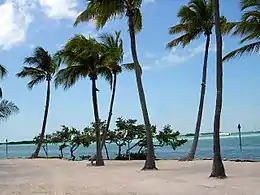
The majority of the symbols were chosen after 1950; only the two oldest symbols—the state flower (chosen in 1909), and the state bird (chosen in 1927), and the state nickname (chosen in 1970)—are not listed in the 2010 Florida Statutes.[331]
- Amphibian: Barking tree frog
- Animal: Florida panther
- Anthem: "Florida (Where the Sawgrass Meets the Sky)"
- Beverage: Orange juice
- Bird: Northern mockingbird
- Bird: American flamingo
- Festival: "Calle Ocho-Open House 8"
- Fish
(fresh water): Florida largemouth bass - Fish
(salt water): Atlantic sailfish - Flower: Orange blossom
- Fruit: Orange
- Gem: Moonstone
- Horse: Florida Cracker Horse
- Insect: Zebra longwing
- Mammal
(salt water): Common bottlenose dolphin - Mammal
(marine): Florida manatee - Motto: "In God We Trust"
- Nickname: The Sunshine State
- Palm Tree: Coconut palm
- Pie: Key lime pie
- Play: Cross and Sword
- Reptile: American alligator
- Reptile
(salt water): Loggerhead sea turtle - Rodeo: Silver Spurs Rodeo
- Shell: Horse conch
- Soil: Myakka soil
- Song: "Old Folks at Home"
- State day/week: Pascua Florida
- Stone: Agatized coral
- Tortoise: Gopher tortoise
- Tree: Sabal palmetto
- Wildflower: Tickseed
Sister states
| Sister jurisdiction | Country | Year[332] |
|---|---|---|
| Languedoc-Roussillon | 1989 | |
| Taiwan Province | 1992 | |
| Wakayama Prefecture | 1995 | |
| Western Cape | 1995 | |
| Nueva Esparta | 1999 | |
| Kyonggi | 2000 |
References
- "Florida | Map, Population, History, & Facts". Encyclopedia Britannica. Retrieved June 30, 2020.
- "Florida | State Facts & History". www.infoplease.com. Retrieved June 30, 2020.
- "Florida". www.americaslibrary.gov. Retrieved June 30, 2020.
- "State Motto". Florida Department of State. Retrieved September 14, 2018.
- "Jacksonville, Fla.: Population, Weather, Demographics, Facts, History, Mayor, Landmarks". www.factmonster.com. Retrieved June 30, 2020.
- "United States Summary: 2010. Population and Housing Unit Counts. 2010 Census of Population and Housing" (PDF). United States Census Bureau. September 2012. p. 41. Retrieved April 9, 2019.
- "Elevations and Distances in the United States". United States Geological Survey. 2001. Archived from the original on October 15, 2011. Retrieved October 21, 2011.
- Elevation adjusted to North American Vertical Datum of 1988.
- "Population and Housing Unit Estimates". United States Census Bureau. January 9, 2020. Retrieved January 9, 2020.
- "Median Annual Household Income". The US Census Bureau. Retrieved January 26, 2020.
- "Article 2, Section 9, Constitution of the State of Florida". State of Florida. 1988. Retrieved September 14, 2018.
- "Florida". Modern Language Association. Retrieved June 29, 2014.
- "SB 230—State Symbols/Fla. Cracker Horse/Loggerhead Turtle [RPCC]". Florida House of Representatives. Retrieved April 7, 2012.
- Wells, John C. (2008). Longman Pronunciation Dictionary (3rd ed.). Longman. ISBN 978-1-4058-8118-0.
- "Gross Domestic Product by State: Second Quarter 2018" (PDF). Bea.gov. Retrieved October 23, 2018.
- "Juan Ponce de León Landing". www.brevardparks.com. Archived from the original on December 21, 2010. Retrieved April 3, 2011.
- Megan Garber. "Science: Several U.S. States, Led by Florida, Are Flatter Than a Pancake". The Atlantic.
- Gardner, Rusty. "Welcome to the Lake Okeechobee". Florida by Water.
- "The Ultimate Guide to Florida's East Coast Beaches". Visitflorida.com.
- "The Top Ten: States with Longest Coastlines". InfoPlease.
- McGovern, Bernie (2007). Florida Almanac (2007–08 ed.). p. 480. ISBN 9781455604418.
- "Florida Islands—The Florida Keys". Floridakeys-guide.com.
- "Köppen Climate Classification Map". John Abbott College, Geosciences Department. Archived from the original on July 6, 2011. Retrieved July 18, 2007.
- "NOAA CoRIS—Regional Portal—Florida". Coris.noaa.gov.
- The biggest coral reef in the continental U.S. is dissolving into the ocean. Retrieved May 6, 2016.
- Administration, US Department of Commerce, National Oceanic and Atmospheric. "NOAA CoRIS—Regional Portal—Florida". coris.noaa.gov. Retrieved October 23, 2018.
- Jonathan D. Steigman (September 25, 2005). La Florida Del Inca and the Struggle for Social Equality in Colonial Spanish America. University of Alabama Press. p. 33. ISBN 978-0-8173-5257-8.
- From the 1601 publication by the pre-eminent historian of 16th-century Spanish exploration in America, Antonio de Herrera y Tordesillas, in Stewart, George (1945). Names on the Land: A Historical Account of Place-Naming in the United States. New York: Random House. pp. 11–12. ISBN 978-1-59017-273-5.
- "Michael Francis: La historia entre Florida y España es de las más ricas de Estados Unidos". Retrieved July 18, 2016.
- Davidson, James West. After the Fact: The Art of Historical Detection Volume 1. Mc Graw Hill, New York 2010, Chapter 1, p. 7.
- Proclamation, presented by Dennis O. Freytes, MPA, MHR, BBA, Chair/Facilitator, 500th Florida Discovery Council Round Table, VP NAUS SE Region; Chair Hispanic Achievers Grant Council
- Hoffman, Paul E., 1943- (2004). A new Andalucia and a way to the Orient : the American Southeast during the sixteenth century. Baton Rouge: Louisiana State University Press. p. 278. ISBN 0-8071-1552-5. OCLC 20594668.CS1 maint: multiple names: authors list (link)
- "Los Floridanos". Los Floridanos.
- J. Michael Francis, PhD, Luisa de Abrego: Marriage, Bigamy, and the Spanish Inquisition, University of South Florida
- Gene Allen Smith, Texas Christian University, Sanctuary in the Spanish Empire: An African American officer earns freedom in Florida, National Park Service
- Pope, Sarah Dillard. "Aboard the Underground Railroad—Fort Mose Site". Nps.gov.
- "Fort Mose Historical Society". Retrieved July 18, 2016.
- Florida Center for Instructional Technology. "Floripedia: Florida: As a British Colony". Fcit.usf.edu. Retrieved October 2, 2009.
- Wood, Wayne (1992). Jacksonville's Architectural Heritage. University Press of Florida. p. 22. ISBN 978-0-8130-0953-7.
- Beach, William Wallace (1877). The Indian Miscellany. J. Munsel. p. 125.
- Wells, Judy (March 2, 2000). "City had humble beginnings on the banks of the St. Johns". The Florida Times-Union. Retrieved July 2, 2011.
- A History of Florida. Caroline Mays Brevard, Henry Eastman Bennett p. 77
- A History of Florida. Caroline Mays Brevard, Henry Eastman Bennett
- The Land Policy in British East Florida. Charles L. Mowat, 1940
- Clark, James C.; "200 Quick Looks at Florida History" p. 20 ISBN 1561642002
- "Transfer of Florida". fcit.usf.edu.
- Ste Claire, Dana (2006). Cracker: Cracker Culture in Florida History. University Press of Florida. ISBN 978-0-8130-3028-9
- "Florida's Early Constitutions—Florida Memory". Retrieved July 16, 2017.
- Alexander Deconde, A History of American Foreign Policy (1963) p. 127
- Tebeau, Charlton W. (1971). A History of Florida. Coral Gables, Florida: University of Miami Press. pp. 114–118.
- "A Century of Lawmaking for a New Nation: U.S. Congressional Documents and Debates, 1774–1875". loc.gov. Retrieved July 21, 2015.
- "Andrew Jackson". Florida Department of State. Retrieved July 18, 2016.
- "A Century of Lawmaking for a New Nation: U.S. Congressional Documents and Debates, 1774–1875". loc.gov. Retrieved July 21, 2015.
- "A Century of Lawmaking for a New Nation: U.S. Congressional Documents and Debates, 1774–1875". loc.gov. Retrieved July 21, 2015.
- "Florida state population". population.us. Retrieved May 19, 2019.
- Tindall, George Brown, and David Emory Shi. (edition unknown) America: A Narrative History. W. W. Norton & Company. 412. ISBN 978-0-393-96874-3
- Historical Census Browser, Retrieved October 31, 2007 Archived August 23, 2007, at the Wayback Machine
- "Ordinance of Secession, 1861". Florida Memory. State Library & Archives of Florida. Retrieved October 22, 2019.
- "Florida Seceded! January 10, 1861|America's Story from America's Library". America's Library. Retrieved November 14, 2017.
- Florida, State Library and Archives of. "Florida in the Civil War". Florida Memory. Retrieved May 19, 2019.
- Taylor, R. (1988). Rebel Beef: Florida Cattle and the Confederate Army, 1862-1864. The Florida Historical Quarterly, 67(1), 15-31. Retrieved from http://www.jstor.org/stable/30147921
- Taylor, Paul. (2012) Discovering the Civil War in Florida: A Reader and Guide (2nd edition). pp. 3–4, 59, 127. Sarasota, Fl.: Pineapple Press.
- Nancy A. Hewitt (2001). Southern Discomfort: Women's Activism in Tampa, Florida, 1880s–1920s. University of Illinois Press. p. 22. ISBN 978-0-252-02682-9.
- Historical Census Browser, 1900 Federal Census, University of Virginia Archived January 11, 2020, at the Wayback Machine. Retrieved March 15, 2008.
- Rogers, Maxine D.; Rivers, Larry E.; Colburn, David R.; Dye, R. Tom & Rogers, William W. (December 1993), "Documented History of the Incident Which Occurred at Rosewood, Florida in January 1923" Archived May 15, 2008, at the Wayback Machine, p. 5. Retrieved April 9, 2011.
- "Florida Department of Agriculture and Consumer Services Statistics".
- Federal Writers' Project (1939). Florida. A Guide to the Southernmost State. New York: Oxford University Press. p. 7.
- "Freedom Tower—American Latino Heritage: A Discover Our Shared Heritage Travel Itinerary". Nps.gov.
- Munzenrieder, Kyle (December 23, 2014). "Florida Is Now Officially the Third Most Populous State". Miaminewtimes.com.
- Lea, Brittany De (August 9, 2019). "Florida to see population boom over coming years as SALT deductions remain capped". FOXBusiness.
- Millsap, Adam. "Florida's Population Is Booming--But Should We Worry About Income Growth?". Forbes.
- "A Great Migration From Puerto Rico Is Set to Transform Orlando". The New York Times. November 17, 2017.
- Office of Ocean and Coastal Resource Management (July 1, 2011). "State Coastal Zone Boundaries" (PDF). National Oceanic and Atmospheric Administration. Retrieved October 28, 2011.
- Main, Martin B.; Allen, Ginger M. (July 2007). "The Florida Environment: An Overview". University of Florida, Institute of Food and Agricultural Sciences. Archived from the original on December 4, 2010. Retrieved January 23, 2008.
- "Green Mountain Scenic Byway". Florida Department of Transportation. Archived from the original on March 6, 2008. Retrieved January 23, 2008.
- Ritter, Michael. "Wet/Dry Tropical Climate". University of Wisconsin, Stevens Point. Archived from the original on November 24, 2010. Retrieved July 18, 2007.
- "Average Annual Temperature for Each US State". Current Results Nexus. Retrieved August 19, 2011.
- "Hottest States in the US—Current Results". Currentresults.com.
- "Cold Weather Hazards". National Weather Service Miami, Florida. Retrieved June 19, 2018.
- "Hazardous Weather: A Florida Guide—Temperatures". FloridaDisaster.org. Retrieved October 9, 2016.
- "Temperature Extremes". Mymanatee.org. June 11, 2012. Retrieved October 9, 2016.
- "Has It Ever Snowed in Florida?". Worldatlas.com.
- Geggis, Anne. "Brrrrr! South Florida may see frost by week's end". Sun-sentinel.com.
- United States National Arboretum. "Florida Hardiness Zones". St Johns River Water Management District. Retrieved March 25, 2011.
- "Dense Fog Advisory". miami.cbslocal.com.
- "NowData—NOAA Online Weather Data". National Oceanic and Atmospheric Administration. Retrieved March 5, 2012.
- "NowData—NOAA Online Weather Data". National Oceanic and Atmospheric Administration. Retrieved March 5, 2012.
- "NowData—NOAA Online Weather Data". National Oceanic and Atmospheric Administration. Retrieved March 5, 2012.
- "PENSACOLA FAA ARPT, FLORIDA—Climate Summary". Southeast Regional Climate Center. Archived from the original on January 18, 2008. Retrieved January 26, 2008.
- "NowData—NOAA Online Weather Data". National Oceanic and Atmospheric Administration. Retrieved March 5, 2012.
- "NowData—NOAA Online Weather Data". National Oceanic and Atmospheric Administration. Retrieved March 5, 2012.
- "Lightning Information Center". National Weather Service. Archived from the original on May 9, 2009. Retrieved January 23, 2008.
- "Total Precipitation in inches by month". NOAA. Retrieved March 31, 2013.
- "Thunderstorms—Florida Climate Center". climatecenter.fsu.edu.
- "united states annual sunshine map" (PDF). HowStuffWorks, Inc. Archived from the original (PDF) on December 12, 2019. Retrieved July 16, 2019.
- Aten, Tim (July 1, 2007). "Waterspouts common off coastal Florida in summer". Naples Daily News. Archived from the original on December 5, 2010. Retrieved January 23, 2008.
- "Hail Storm". miami.cbslocal.com.
- "Florida is US lightning capital". Florida Today Factbook. March 28, 2009. p. 34.
- "How Often Hurricanes Make Landfall in Florida". Tripsavvy.com.
- "The 25th Anniversary of Hurricane Andrew". Aoml.noaa.gov.
- "Leatherback Nesting in Florida". myfwc.com.
- Morgan, Curtis (April 9, 2012). "Crocs crawl back to coast". Florida Today. Melbourne, Florida. pp. 8B. Archived from the original on April 10, 2012.
- Winston, Keith (December 24, 2013). "Predator animals rebound". Florida Today. Melbourne, Florida. pp. 7B. Archived from the original on March 16, 2015. Retrieved December 29, 2013.
- "Surprising Origin of American Flamingos Discovered". News.mationalgeographic.com. March 10, 2018.
- C. Michael Hogan. 2008. Wild turkey: Meleagris gallopavo, GlobalTwitcher.com, ed. N. Stromberg Archived July 25, 2017, at the Wayback Machine
- Winsten, Keith (January 7, 2014). "'Snow' bird species in South". Florida Today. Melbourne, Florida. pp. 7B. Archived from the original on January 9, 2014. Retrieved January 7, 2014.
- "BIOLOGICAL CONTROL OF INVASIVE INSECT PESTS OF CROPS AND NATIVE FLORA IN FLORIDA". Usda.gov/.
- "Nonnative Species". myfwc.com.
- Waymer, Jim (April 1, 2020). "Florida forests help roll out toilet paper". Florida Today. Melbourne, Florida. pp. 1A, 10A. Retrieved April 4, 2020.
- "Native Plants—University of Florida, Institute of Food and Agricultural Sciences". gardeningsolutions.ifas.ufl.edu.
- Sonnenberg, Maria (September 21, 2013). "Florida's flowers". Florida Today. Melbourne, Florida. p. 1D. Archived from the original on March 16, 2015. Retrieved September 21, 2013.
- Crane, Timothy K. Broschat and Jonathan H. (April 4, 2018). "The Coconut Palm in Florida". edis.ifas.ufl.edu.
- "The biggest coral reef in the continental U.S. is dissolving into the ocean". Washington Post.
- US Department of Commerce, National Oceanic and Atmospheric Administration. "NOAA CoRIS—Regional Portal—Florida". www.coris.noaa.gov. Retrieved May 19, 2019.
- "About—Pennekamp Coral Reef State Park". pennekamppark.com. Retrieved May 19, 2019.
- "SOFIA—Circular 1134—the Natural System—Florida Reef Tract". archive.usgs.gov. Retrieved May 19, 2019.
- "Energy Consumption by Source and Total Consumption per Capita, Ranked by State, 2004" (PDF). U.S. Department of Energy. Archived (PDF) from the original on January 15, 2010. Retrieved January 27, 2008.
- "State Energy Profiles: Florida". U.S. Department of Energy. Archived from the original on January 7, 2008. Retrieved January 27, 2008.
- "Current Wildfire Conditions / Wildland Fire / Florida Forest Service / Divisions & Offices / Home—Florida Department of Agriculture & Consumer Services". Freshfromflorida.com. Retrieved October 23, 2018.
- "Florida Statutes". Leg.state.fl.us. Retrieved November 4, 2011.
- Daley, Beth (March 28, 2005). "Tide's toxins trouble lungs ashore". Boston Globe. Archived from the original on February 16, 2012. Retrieved December 3, 2007.
- "Why Florida's red tide is killing fish, manatees, and turtles". Vox.com.
- Williams Hale, Leslie (December 29, 2009). "Record number of panthers killed by vehicles in 2009". Naples News. Archived from the original on December 5, 2010. Retrieved January 1, 2010.
- "More manatees have died in Florida so far this year than in all of 2017. Here's why". Miamiherald.com.
- "Florida's Long-Lost Wild Flamingos Were Hiding in Plain Sight". Npr.org.
- "Now that we agree these flamingos are Florida natives, it's time to protect them, experts say". Miamiherald.com.
- Jeff Goodell (June 20, 2013). "Goodbye, Miami". Rolling Stone. Retrieved June 21, 2013.
- "Where Sand Is Gold, the Reserves Are Running Dry". The New York Times. August 25, 2013.
- Precht and Miller:243–44, 245, 247–48, 249
The State of Coral Reef Ecosystems of the Florida Keys Accessed December 17, 2010 - Wilkinson, Jerry. "History of Keys Geology". Keyshistory.org.
- "Industry overview". First research. Hoover's. March 25, 2010. Archived from the original on February 14, 2010.
- Parsons, Victoria (Spring 2011). "The Real Cost of Fertilizer". Bay Soundings. Retrieved June 21, 2014.
- "Florida Springs, Springs in Florida, Florida Cave Diving—Florida's Springs: Protecting Nature's Gems—Florida DEP—Springshed Map". February 11, 2011. Archived from the original on February 11, 2011. Retrieved May 19, 2019.
- Allen, Ginger M.; Main, Martin B (May 2005). "Florida's Geological History". Florida Cooperative Extension Service. University of Florida. Archived from the original on December 4, 2010. Retrieved January 20, 2009.
- Tihansky, Ann B. "Sinkholes, West-Central Florida. A link between surface water and ground water" (PDF). U.S. Geological Survey, Tampa, Florida. Retrieved June 21, 2014.
- "Sinkhole Maps of Florida Counties". Florida Center for Instructional Technology, College of Education. University of South Florida. 2007. Retrieved June 21, 2014.
- "State Farm seeks 28% rate hike". Florida Today. Melbourne, Florida. February 16, 2011. p. 8B. Archived from the original on February 19, 2011.
- Huber, Red (November 13, 2012). "Looking back at Winter Park's famous sinkhole". Orlando Sentinel.
- U.S. Geological Survey. National Hydrography Dataset high-resolution flowline data. The National Map Archived March 29, 2012, at the Wayback Machine, accessed April 21, 2011
- (2013-01-02). "Econlockhatchee River". Saint Johns River Water Management District. Retrieved on August 4, 2014.
- "Florida's Earthquake History and Tectonic Setting". Decodedscience.org. January 23, 2015.
- Resident Population Data. "Resident Population Data—2010 Census". 2010.census.gov. Archived from the original on July 21, 2011. Retrieved November 4, 2011.
- "Table 1. Annual Estimates of the Resident Population for the United States, Regions, States, and Puerto Rico: April 1, 2010 to July 1, 2019". U.S. Census Bureau. January 29, 2019. Retrieved January 4, 2019.
- Website Services & Coordination Staff (WSCS). "2010 Census Interactive Population Search". census.gov. Archived from the original on August 14, 2013. Retrieved July 21, 2015.
- Weissmann, Jordan (December 22, 2012). "The Fastest-Growing States in America (and Why They're Booming)". The Atlantic. Retrieved August 14, 2014.
- "Florida's Population Center Migrates through History". University of Florida Bureau of Economic and Business Research. Archived from the original on August 14, 2013. Retrieved August 14, 2014.
- "Florida Leaves New York Behind in Its Rear-View Mirror—National Review". Nationalreview.com. December 23, 2014. Retrieved October 23, 2018.
- Pramuk, Jacob (December 23, 2014). "Move over, NY: This state now 3rd most populous". Cnbc.com.
- "Florida Demographics—Get Current Census Data for Florida". www.florida-demographics.com. Retrieved May 19, 2019.
- Michael B. Sauter; Douglas A. McIntyre (May 10, 2011). "The States with the Oldest And Youngest Residents". wallst.com.
- "Retired Military Personnel". The Intercom. Patrick Air Force Base, Florida: Military Officers Association of Cape Canaveral. June 2009. p. 4.
- Amy Goodman (April 6, 2009). ""A Ponzi State"—Univ. of South Florida Professor Examines the Economic Crisis in Florida". Democracy Now!.
- Slevin, Peter (April 30, 2010). "New Arizona law puts police in 'tenuous' spot". The Washington Post. Washington, D.C. p. A4. Archived from the original on November 10, 2012.
- behind Nevada, Arizona, New Jersey, California and Texas
- Reed, Matt (January 18, 2011). "E-Verify best way to find illegals". Florida Today. Melbourne, Florida. p. 1B. Archived from the original on May 4, 2014.
- Shoichet, Catherine E. (May 9, 2019). "Florida is about to ban sanctuary cities. At least 11 other states have, too". CNN.
- Population Division, Laura K. Yax. "Historical Census Statistics on Population Totals By Race, 1790 to 1990, and By Hispanic Origin, 1970 to 1990, For The United States, Regions, Divisions, and States". Archived from the original on December 24, 2014.
- Center for New Media and Promotions(C2PO). "2010 Census Data". Census.gov.
- "U.S. Census Bureau QuickFacts: Florida". Census Bureau QuickFacts.
- "Race, Hispanic or Latino, Age, and Housing Occupancy: 2010" . 2010 Census Redistricting Data (Public Law 94-171) Summary File. U.S. Census Bureau. Retrieved November 14, 2011.
- Exner, Rich. "Americans under age 1 now mostly minorities, but not in Ohio: Statistical Snapshot". cleveland.com. Advance Ohio. Retrieved August 2, 2016.
- Millsap, Adam. "Big Metro Areas in Florida Keep Getting Bigger". Forbes.com.
- "Local Government Vocabulary". Florida League of Cities. Archived from the original on November 10, 2013. Retrieved May 15, 2012.
- "Population data" (PDF). bebr.ufl.edu. 2005. Retrieved November 9, 2019.
- Fishkind, Hank (November 9, 2013). "Beaches are critically important to us". Florida Today. Melbourne, Florida. pp. 4B. Retrieved November 11, 2013.
- "Annual Estimates of the Resident Population for Incorporated Places of 50,000 or More, Ranked by July 1, 2018 Population: April 1, 2010 to July 1, 2018". US Census. May 2019. Retrieved September 21, 2019.
- "Florida Profile of General Population and Housing Characteristics: 2010 Demographic Profile Data". United States Census Bureau. Retrieved October 27, 2015.
- "Florida: SELECTED SOCIAL CHARACTERISTICS IN THE UNITED STATES—2006–2010 American Community Survey 5-Year Estimates". United States Census Bureau. Retrieved October 27, 2015.
- "Florida Factstreet". US Census Bureau. Archived from the original on February 12, 2020. Retrieved December 3, 2007.
- Pulera, Dominic (October 20, 2004). Sharing the Dream: White Males in Multicultural America. A&C Black. ISBN 9780826416438. Retrieved October 23, 2018 – via Google Books.
- Reynolds Farley, 'The New Census Question about Ancestry: What Did It Tell Us?', Demography, Vol. 28, No. 3 (August 1991), pp. 414, 421.
- Stanley Lieberson and Lawrence Santi, 'The Use of Nativity Data to Estimate Ethnic Characteristics and Patterns', Social Science Research, Vol. 14, No. 1 (1985), pp. 44–6.
- Stanley Lieberson and Mary C. Waters, 'Ethnic Groups in Flux: The Changing Ethnic Responses of American Whites', Annals of the American Academy of Political and Social Science, Vol. 487, No. 79 (September 1986), pp. 82–86.
- Mary C. Waters, Ethnic Options: Choosing Identities in America (Berkeley: University of California Press, 1990), p. 36.
- "Ancestry of the Population by State: 1980—Table 3" (PDF). Retrieved November 4, 2011.
- "Historical Census Statistics on Population Totals By Race, 1790 to 1990, and By Hispanic Origin, 1970 to 1990, For The United States, Regions, Divisions, and States". U.S. Census Bureau. Archived from the original on December 24, 2014. Retrieved January 3, 2012.
- David Hackett Fischer, Albion's Seed: Four British Folkways in America, New York: Oxford University Press, 1989, pp.633–639
- "Miami, Florida Race and Hispanic or Latino Origin: 2010 Census Summary File 1". American FactFinder. US Census Bureau. Archived from the original on February 12, 2020. Retrieved October 27, 2015.
- "Florida Hispanic or Latino by Type: 2010 Census Summary File 1". United States Census Bureau. Retrieved October 26, 2015.
- Data Access and Dissemination Systems (DADS). "American FactFinder—Results". census.gov. Archived from the original on February 12, 2020. Retrieved July 21, 2015.
- "Thedailyjournal—Puerto Rico's population exodus is all about jobs". usatoday.com. Retrieved July 21, 2015.
- Brinkmann, Paul. "How many Puerto Ricans have moved to Florida? State's numbers questioned". Orlandosentinel.com.
- "Compendium of the Ninth Census:Population, with race" (PDF). US Census Bureau. p. 14. Archived (PDF) from the original on August 8, 2010. Retrieved December 3, 2007.
- "Historical Census Browser: 1960 US Census". University of Virginia, Geospatial and Statistical Data Center. University of Virginia Library. 2004. Archived from the original on August 8, 2007. Retrieved August 29, 2008.
- "As Caribbean immigration rises, Miami's black population becomes more foreign". Miamiherald.com.
- "Grid View: Table B04006—Census Reporter". censusreporter.org.
- "Immigrants in Florida". Americanmigrationcouncil.org. January 1, 2015.
- "Florida". Modern Language Association. Retrieved August 11, 2013.
- MacDonald, Victoria M. (April 2004). "The Status of English Language Learners in Florida: Trends and Prospects" (PDF). Education Policy Research Unit, Arizona State University. Archived from the original (PDF) on February 9, 2014. Retrieved May 24, 2013.
- "Jewish Population of the United States, by State (2011)". Jewish Virtual Library. Retrieved September 13, 2013.
- "The Association of Religion Data Archives | State Membership Report". www.thearda.com. Retrieved November 15, 2013.
- Pew Research Center, "Religious Landscape Study: Florida"
- "Religious Landscape Study". Pew Forum. May 11, 2015.
- "Editorial:Culture of corruption". Florida Today. Melbourne, Florida. January 7, 2011. p. 1A. Archived from the original on January 7, 2014.
- "Alabama : Federal Taxes Paid vs. Federal Spending Received : 1981–present" (PDF). Files.taxfoundation.org. Retrieved October 23, 2018.
- "Voter Registration—Current by County—Division of Elections—Florida Department of State". October 24, 2016. Archived from the original on October 24, 2016.
- Saxon, Wolfgang (October 27, 2003). "William C. Cramer, 81, a Leader of G.O.P. Resurgence in South". The New York Times. Retrieved February 26, 2008.
- "Claude Roy Kirk, Jr". Office of Cultural and Historic Programs, State of Florida. Archived from the original on August 18, 2007. Retrieved February 26, 2008.
- Thomas, Jr, Robert McG (May 23, 1996). "E. J. Gurney, 82, Senator Who Backed Nixon". The New York Times. Retrieved February 26, 2008.
- "What Is a Bellwether State?". Ask.com. Archived from the original on January 7, 2014. Retrieved January 7, 2014.
- Navarro, Mireya (September 21, 1998). "Florida's Split: Will It Play in the Panhandle?". The New York Times. Retrieved May 2, 2010.
- Lengell, Sean. "As I-4 corridor goes, so goes Florida". The Washington Times. Archived from the original on January 31, 2008.
- "Voter Registration by Party Affiliation and County". Florida Department of State. January 2008. Archived from the original on November 24, 2011. Retrieved February 26, 2008.
- "U.S. Electoral College". Archived from the original on November 21, 2010.
- "Florida Certificate of Vote". Archived from the original on September 19, 2011.
- Leary, Alex: "Florida gains two U.S. House seats in Census" Archived December 24, 2010, at the Wayback Machine, St. Petersburg Times, December 21, 2010
- Pear, Robert. "Elections 2012, State Results". The New York Times. Retrieved April 15, 2013.
- "Florida". 270towin.com. January 2, 2010.
- See Bush v. Gore, 531 U.S. 98 (2000)
- See also Bush v. Palm Beach County Canvassing Board, 531 U.S. 70 (2000).
- Fessenden, Ford; Broder, John M. (November 12, 2001). "Study of Disputed Florida Ballots Finds Justices Did Not Cast the Deciding Vote". The New York Times.
- Cf. Fla. Stat. § 103.011 (web version) ("Votes cast for the actual candidates for President and Vice President shall be counted as votes cast for the presidential electors supporting such candidates. The Department of State shall certify as elected the presidential electors of the candidates for President and Vice President who receive the highest number of votes.")
- Matt Ford, "Restoring Voting Rights for Felons in Maryland", The Atlantic, February 9, 2016, accessed March 23, 2016
- Mary Ellen Klas, "Florida Supreme Court approves congressional map drawn by challengers", Tampa Bay Times, December 2, 2015, accessed December 11, 2016
- "Voter Registration—By Party Affiliation". Florida Department of State. Archived from the original on September 30, 2019.
- Brent Staples, "Florida Leads the Pack—in Felon Disenfranchisement", The New York Times, November 7, 2014, accessed March 23, 2016
- "Florida's Motor Vehicle : No-Fault Law : Report Number 2006-102" (PDF). Archive.flsenate.gov. Retrieved October 23, 2018.
- "Personal Injury Protection (PIP)" (PDF). The Florida Senate, Committee on Banking and Insurance. August 2011. Retrieved February 9, 2012.
- "Corruption at Miami-Dade auto accident clinics creates huge financial burden on drivers". United Auto Courts Report. United Auto Insurance Co. January 15, 2012. Archived from the original on May 15, 2012. Retrieved February 9, 2012.
- Deslatte, Aaron (January 26, 2012). "Scott says PIP program 'has to be fixed'". Orlando Sentinel. Archived from the original on May 25, 2017.
- Mitchell, Tia (January 25, 2012). "Scott-backed bill to combat fraud advances in House". Miami Herald. Archived from the original on February 11, 2012.
- "House version of PIP reform gets Scott endorsement". Tampa Bay Times. January 25, 2012. Archived from the original on March 23, 2013.
- "Facts about capital punishment—the death penalty". www.religioustolerance.org. Retrieved May 19, 2019.
- The Florida Statutes.
- "FL sentencing guidelines". FL Senate.
- Knapp, Andrew (October 16, 2010). "Crime rate decreases 5.5%". Florida Today. Melbourne, Florida. pp. 1B. Archived from the original on July 12, 2014.
- "The 2010 Florida Statutes". State of Florida. October 16, 2010.
- Haridopolos, Mike (March 11, 2014). "Legislature aims to rewrite gaming rules. 'Complex' issue affects billions of dollars in state revenue". Florida Today. Melbourne, Florida. pp. 1A. Archived from the original on September 24, 2015. Retrieved March 11, 2014.
- "Brickell Neighborhood Guide". Nestseekers.com. Archived from the original on June 29, 2009. Retrieved November 4, 2011.
- "Brickell Real Estate—Millionaires Row". Miamisignaturehomes.com. Retrieved November 4, 2011.
- "U.S. Census Bureau QuickFacts: Florida". www.census.gov.
- "data" (PDF). bea.gov. 2019. Retrieved November 9, 2019.
- Comparison between U.S. states and countries by GDP (nominal)
- "GDP, PPP (current international $)—Data". data.worldbank.org.
- "News—renthomeflorida.com". renthomeflorida.com.
- "Florida's September Employment Figures Released" (PDF). Lmsresources.labormarketinfo.com. September 2018. Retrieved October 23, 2018.
- . October 23, 2018 https://web.archive.org/web/20181023034758/https://apps.bea.gov/regional/bearfacts/pdf.cfm?fips=12000&areatype=STATE&geotype=3. Archived from the original on October 23, 2018. Retrieved May 19, 2019. Missing or empty
|title=(help) - "State Exports from Florida". Census.gov. Retrieved October 23, 2018.
- "Florida State Imports". Census.gov. Retrieved October 23, 2018.
- "Gross Domestic Product by Metropolitan Area, 2017" (PDF). Bea.gov. Retrieved October 23, 2018.
- "The Role of Metro Areas in the US Economy" (PDF). Archived from the original (PDF) on December 16, 2009. Retrieved November 4, 2011.
- "<?xml version="1.0" encoding="UTF-8"?> Sign in Register Help E-mail Address Password Register Forgot your password? E-mail Address Password Verify Password Sign in Forgot your password? E-mail Address Sign in Register Regional Data GDP & Personal Income". Archived from the original on October 23, 2018. Retrieved November 9, 2019.
- "MAPPED: Here's how many millionaires there are in each US state". Businesinsider.com.
- "Site Selection Rankings". Greyhill Advisors. Retrieved October 18, 2011.
- Analysis, US Department of Commerce, BEA, Bureau of Economic. "Bureau of Economic Analysis". apps.bea.gov.
- "Unemployment Rates for States". Bls.gov.
- Loudenback, Tanza (February 6, 2020). "There are 9 US states with no income tax, but 2 of them still tax investment earnings". Business Insider. Insider, Inc. Retrieved March 23, 2020.
- "Florida's Minimum Wage Rates". U.S. Department of Labor. October 15, 2009. Retrieved November 8, 2012.
- Zhao, Helen (February 7, 2018). "These US cities have the highest credit card debt". Cnbc.com.
- Chokey, Aric. "Poverty rate in Florida dips to lowest level since Great Recession, census says". Sun-sentinel.com.
- PineapplePress. "The Two Henrys Henry Plant and Henry Flagler and Their Railroads—Pineapple Press". Pineapplepress.com. Archived from the original on September 3, 2018. Retrieved March 3, 2020.
- "State scores well in credit card, mortgage payment delinquency". The Burlington Free Press. December 3, 2008. Retrieved December 3, 2008.
- Orr, Deborah (January 7, 2009). "America's 25 Weakest Housing Markets". Forbes. Archived from the original on January 22, 2009. Retrieved January 25, 2009.
- "Our views:Playing with fire". Florida Today. March 20, 2009. Archived from the original on March 16, 2015. Retrieved March 22, 2009.
- McCaffrey, Scott (October 15, 2009). "Census Bureau: 1 in 3 Virginians Pays Plenty for Housing". Arlington Sun Gazette. Archived from the original on November 20, 2010. Retrieved October 16, 2009.
- Enrique, Eric (February 27, 2010). "No to noncourt foreclosures". Florida Today. Melbourne, Florida. p. 13A. Archived from the original on March 16, 2015.
- Price, Wayne T. (March 24, 2010). "Area home sales down". Florida Today. Melbourne, Florida. p. 6C. Retrieved March 27, 2011.
- "Interview: Guy Fieri talks new projects, criticism and the Triple D effect at Disney Springs in Orlando". Tampa Bay Times. February 13, 2017. Archived from the original on February 14, 2017. Retrieved February 14, 2017.
- "Gov. Scott: Florida Sets Another Tourism Record". Florida Government. Archived from the original on February 16, 2017. Retrieved February 16, 2017.
- "What They Are Saying ... Florida Leaders Celebrate Record 105 Million Tourists in 2015". Government of Florida. Archived from the original on April 21, 2016. Retrieved April 20, 2016.
- Day, Ashley (March 6, 2016). "Florida shines brightly in spring". USA Today/Florida Today. Melbourne, Florida. pp. 3U. Retrieved March 6, 2016.
- "VISIT FLORIDA Announces an All-Time Record 126 Million Visitors in 2018". Visit Florida. February 20, 2019. Retrieved February 20, 2020.
- Waymer, Jim (February 15, 2010). "Beaches get pumped up". Florida Today. Melbourne, Florida. p. 13A. Archived from the original on February 17, 2010.
- "Laying out an "unwelcome mat" to public beach access" (PDF). Archived from the original (PDF) on May 20, 2012. Retrieved November 4, 2011.
- "TEA/AECOM 2018 Theme Index and Museum Index: The Global Attractions Attendance Report" (PDF). Themed Entertainment Association. May 28, 2019. Retrieved February 20, 2020.
- "10 Most Popular Theme Parks in the World—US City Traveler". Uscitytraveler.com. Retrieved October 23, 2018.
- "Florida Theme Parks—Discover the Best Amusement Parks in Florida". Visit Florida.
- Bray, Taryn. "Florida Parks Receive Record Number of Gold Medals For Excellence". Retrieved May 19, 2019.
- Walton, Justin (October 13, 2015). "Florida's Economy: The 6 Industries Driving GDP Growth". Investopedia.com.
- "Commodity Profile: Citrus" (PDF). Agricultural Issues Center, University of California. Archived (PDF) from the original on March 31, 2010. Retrieved November 17, 2007.
- Doering, Christopher (February 5, 2014). "Nelson lauds effect for state, Rubio opposes wide reach". Florida Today. Melbourne, Florida. p. 1A. Retrieved February 5, 2014.
- Doug Mayo (June 28, 2019). "Florida Panhandle Ag Facts from the 2017 Ag Census". Panhandle Agriculture. Archived from the original on July 8, 2019.
- "Crop Profile for Celery in Florida". NSF Center for Integrated Pest Management, North Carolina State University. Archived from the original on August 9, 2010. Retrieved November 17, 2007.
- "Corn, Green Bean Prices Rise After Florida Freezes". Calorielab. January 1, 2011.
- "Pollutants threaten the Everglades' future". Earthmagazine.org. January 5, 2012.
- Price, Wayne T. (February 23, 2010). "Locals to protest fish regulation". Florida Today. Melbourne, Florida. p. 8C. Archived from the original on February 7, 2015.
- Moore, Mary Helen (October 8, 2018). "Berry poachers at heart of change in harvest rules". Florida Today. Melbourne, Florida. pp. 1A. Retrieved October 9, 2018.
- Price, Wayne T. (February 10, 2015). "Sea Ray Boats to resume operations". Florida Today. Melbourne, Florida. p. 1A. Retrieved February 11, 2015.
- "About Phosphate". The Mosaic Company. Archived from the original on September 23, 2007. Retrieved November 17, 2007.
- "TSRI Plans to Open Major Science Center in Palm Beach County, Florida". News & Views. The Scripps Research Institute. October 2003. Retrieved May 14, 2012.
- "State-by-State Listing of Major U.S. Military Bases—Florida". Archived from the original on December 8, 2010. Retrieved July 6, 2009.
- Ash, Jim (April 15, 2009). "Military-friendly bill cruise". Florida Today. Melbourne, Florida. p. 9B.
- Waymer, Jim (April 7, 2011). "Shutdown spares essential services". Florida Today. Melbourne, Florida. pp. 1A. Archived from the original on September 4, 2014.
- "Study: Government a top employer in Florida". Florida Today. Melbourne, Florida. May 16, 2012. p. 12B. Archived from the original on September 4, 2014. Retrieved May 16, 2012.
- Forgione, Mary. "World's busiest cruise ports are in Florida". latimes.com.
- "Top 50 Water Ports by Tonnage—Bureau of Transportation Statistics". Bts.gov.
- "Port Tampa Bay". Port Tampa Bay.
- Hobson, Will (January 16, 2010). "County Medicaid tab rises, could get worse". The Miami Herald. Archived from the original on August 17, 2011.
- Ryan, MacKenzie (December 26, 2010). "Qualifying for care a minefield" (PDF). Florida Today. Melbourne, Florida. p. 3A. Archived from the original (PDF) on December 5, 2010.
- Marshal, James (December 26, 2010). "Sunday debate: No: Longtime official lost touch with voters". =Florida Today. Melbourne, Florida. p. 19A. Archived from the original on August 21, 2013.
- "Opinion—Uninsured in Texas and Florida". The New York Times. Retrieved October 23, 2018.
- "Miami Beach". Bass Museum of Art. Archived from the original on November 22, 2010.
- "Tour Miami's Art Deco District—MiamiAndBeaches.com—Miami and The Beaches". September 18, 2018. Archived from the original on September 18, 2018. Retrieved May 19, 2019.
- Ennis Davis (March 6, 2008). "A Century of Florida's Tallest Skyscrapers". Metro Jacksonville. Retrieved April 12, 2016.
- "Wells Fargo Center, Jacksonville". Emporis. Retrieved April 12, 2016.
- Wayne W. Wood. "Jacksonville's Lost Treasures". Prairie School Traveler. Retrieved April 23, 2016.
- "When Does Modern Architecture Become Historic?". Jacksonville Historical Society. Retrieved April 23, 2016.
- "Official: Design rules haven't cost Palm Bay new businesses". Florida Today. Archived from the original on August 25, 2013. Retrieved June 1, 2009.
- "Florida: St. Augustine Town Plan Historic District". National Park Service.
- "Ranking". www.usnews.com. Retrieved November 9, 2019.
- "SAS® Logon Manager". edstats.fldoe.org.
- "Education Spending Per Student by State". Governing.com.
- "League of United Latin American Citizens (LULAC) et al. vs. State Board of Education et al. Consent Decree". United States District Court for the Southern District of Florida. August 14, 1990. Archived from the original on June 17, 2013. Retrieved May 24, 2013.
- "Florida College System, 2013 Annual Report" (PDF). Archived from the original (PDF) on June 11, 2014.
- "Institutional Knowledge Management—2016–2017 Enrollment". University of Central Florida. Archived from the original on August 24, 2018. Retrieved June 8, 2017.
- "Official website of ICUF". Icuf.org. Retrieved November 4, 2011.
- Atherton, Blair (August 2006). "2005–2006 Accountability Report: Quality, Productivity, Diversity, and Access" (PDF). Archived from the original (PDF) on September 25, 2007. Retrieved September 14, 2007.
- "Higher education in Britain is still good value compared with America". Economist. March 2, 2017. Retrieved March 2, 2017.
- "Timeline". The Florida Memory Project. State Library and Archives of Florida. 1851. Archived from the original on August 1, 2010. Retrieved July 9, 2010.
- Memorial of the Trustees of the University of Florida (R.K. Call, John G. Gamble, Thomas Randall, Louis M. Goldsborough, Thos. Eston Randolph, F. Eppes, E. Loockerman, Benjamin Chaires, Turbutt R. Betton, Fitch W. Taylor, J. Loring Woart, Ashbeel Steele, J. Edwin Stewart), p. cxxiii. United States Congress. December 7, 1835. Retrieved December 13, 2013.
- "Transportation Data and Analytics Office". Florida Department of Transportation. September 4, 2018. Retrieved September 14, 2018.
- Moody, R. Norman (January 30, 2011). "Guidelines tight to drive a fuel tanker". Florida Today. Melbourne, Florida. p. 2A.
- "Recession Marked by Bump in Uninsured Motorists" (PDF). Archived from the original (PDF) on September 2, 2011. Retrieved November 4, 2011.
- Kennerley, Britt (September 18, 2011). "Olde drivers take fewer risks". Florida Today. Melbourne, Florida. p. 11A. Archived from the original on September 27, 2011.
- "Orlando International Airport Busiest in Florida with Record Passenger Traffic in 2017". Orlando International Airport (MCO). Greater Orlando Aviation Authority. February 6, 2018. Archived from the original on January 4, 2020. Retrieved March 28, 2020.
- "Florida Drug Threat Assessment-Overview". National Drug Intelligence Center. Archived from the original on August 31, 2009. Retrieved July 18, 2007.
- "Calendar Year 2017 Enplanements at All Airports (Primary, Non-primary Commercial Service, and General Aviation) by State and Airport, Updated 7 October 2018" (PDF). Retrieved November 9, 2019.
- "All Aboard Florida—Miami to Orlando Passenger Rail Service". Federal Railroad Authority. Retrieved February 17, 2015.
- Broadt, Lisa (January 12, 2018). "First ride: Aboard Florida's new Brightline train". King5. Retrieved January 15, 2018.
- "Amtrak Fact Sheet, Fiscal Year 2011, State of Florida" (PDF). Amtrak. Retrieved April 20, 2016.
- Services, Miami-Dade County Online. "Metrorail—Miami-Dade County". Miamidade.gov.
- "SunRail—A Better Way To Go". sunrail.com.
- "Home—Hillsborough Area Regional Transit Authority". Gohart.org.
- "Pinellas Suncoast Transit Authority—PSTA". Psta.net.
- "Jacksonville Transportation Authority—Skyway". Jtafla.com.
- Peltier, Michael (November 5, 2011). "Lawmaker's bill would fine teams that black out games". Florida Today. Melbourne, Florida. pp. 4B. Archived from the original on January 17, 2013.
- "Miami MLS expansion team to begin play in 2020", MLSsoccer.com, January 29, 2018.
- "State of Florida.com—Florida Professional Sports Teams". Stateofflorida.com.
- "Florida's 7 FBS head coaches explain college football's most chaotic state". Sbnation.com.
- "The 2010 Florida Statutes". Florida Legislature. Retrieved May 21, 2011.
- "Florida Sister City/Sister State Directory 2001" (PDF). State of Florida. 2001. Archived from the original (PDF) on June 27, 2008. Retrieved August 19, 2010.
Bibliography
- Viviana Díaz Balsera and Rachel A. May (eds.), La Florida: Five Hundred Years of Hispanic Presence. Gainesville, Florida: University Press of Florida, 2014.
- Michael Gannon (ed.), The History of Florida. Gainesville, Florida: University Press of Florida, 2013.
External links
- State website
- Florida at Curlie
- Florida State Guide, from the Library of Congress
- Florida Memory Project Over 300,000 photographs and documents from the State Library & Archives of Florida
- Online collection of the Spanish Land Grants
- USGS real-time, geographic, and other scientific resources of Florida
- Florida Rivers and Watersheds—Florida DEP
- U.S. Census Bureau
- Economic and farm demographics fact sheet from the USDA
- Energy & Environmental Data For Florida
- Heliconius charitonia, zebra longwing Florida state butterfly, on the UF / IFAS Featured Creatures Web site
- TerraFly Property Value and Aerial Imagery Spatio-temporal animation Real Estate Trends in Florida
- List of searchable databases produced by Florida state agencies hosted by the American Library Association Government Documents Roundtable
| Preceded by Michigan |
List of U.S. states by date of statehood Admitted on March 3, 1845 (27th) |
Succeeded by Texas |



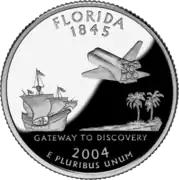
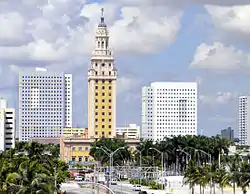
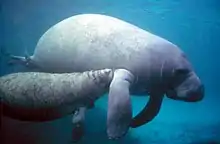
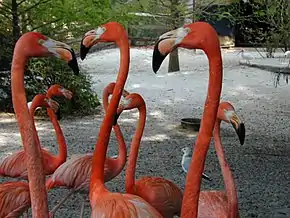

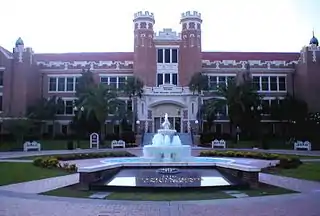
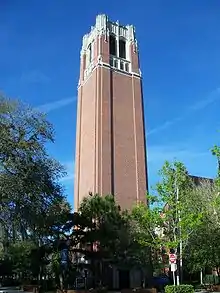
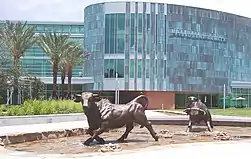
.jpg.webp)

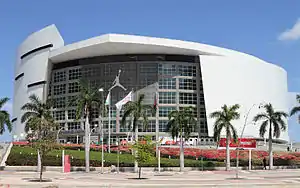
.jpg.webp)
